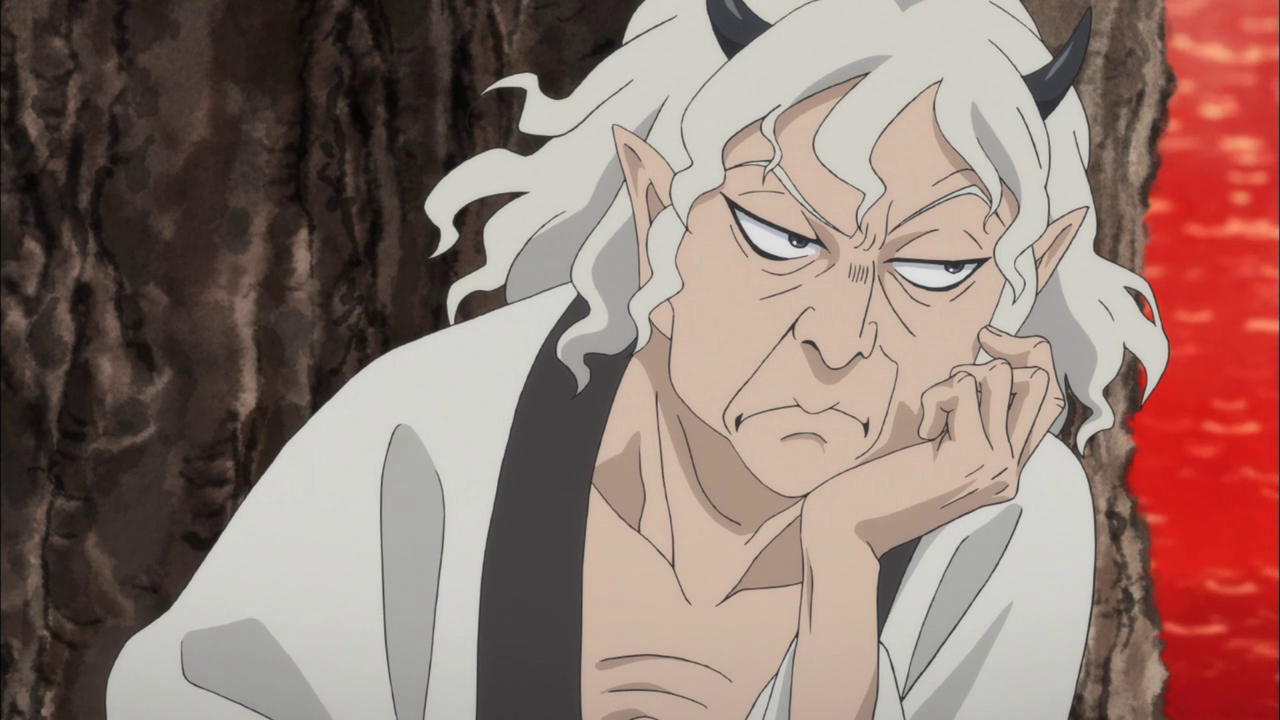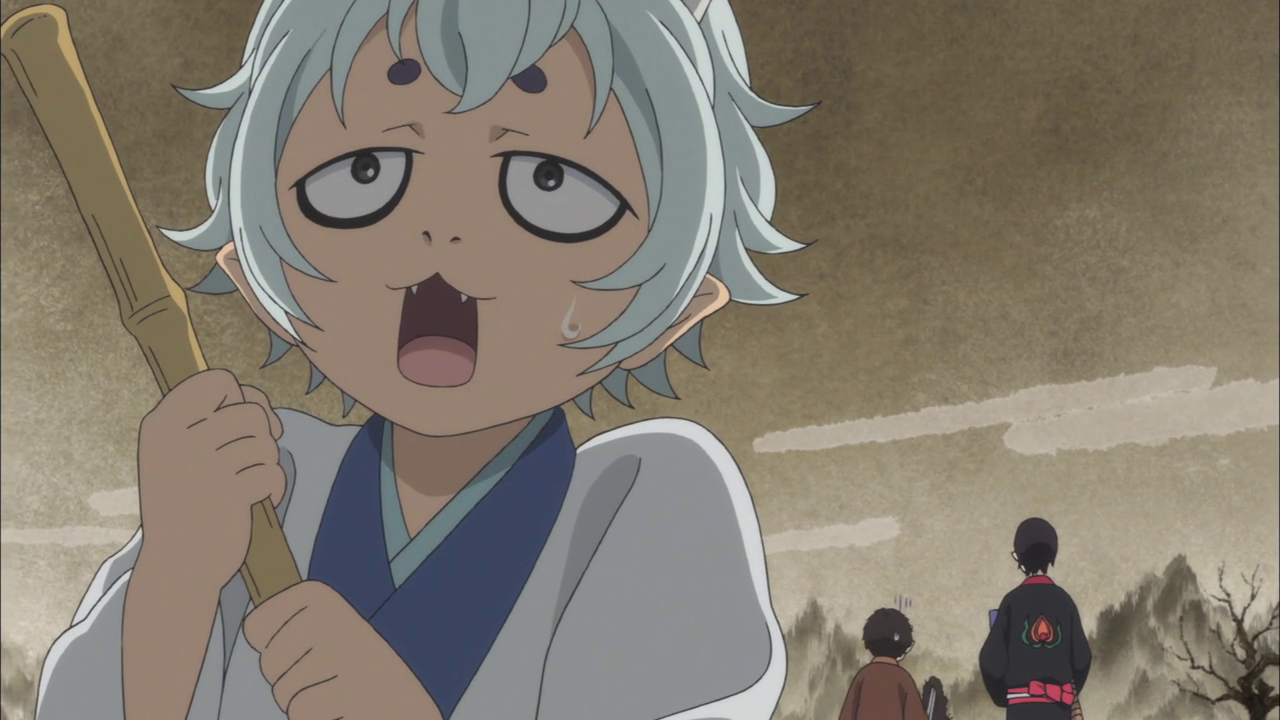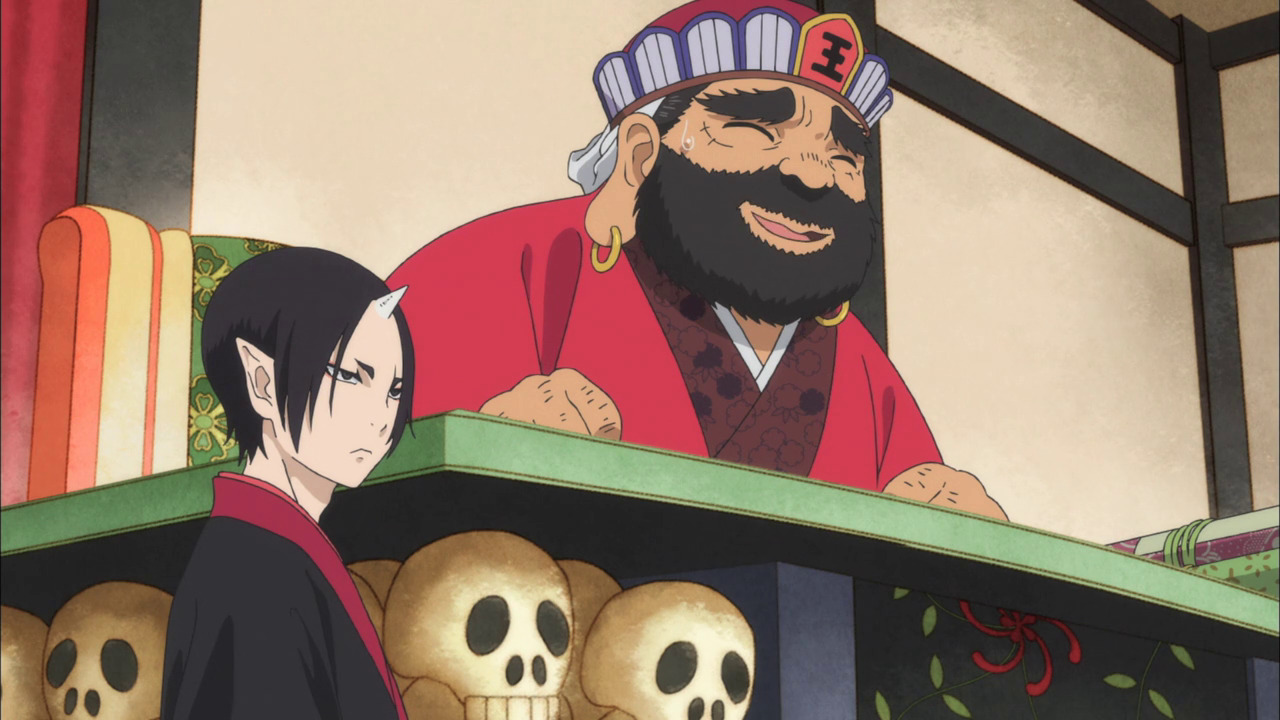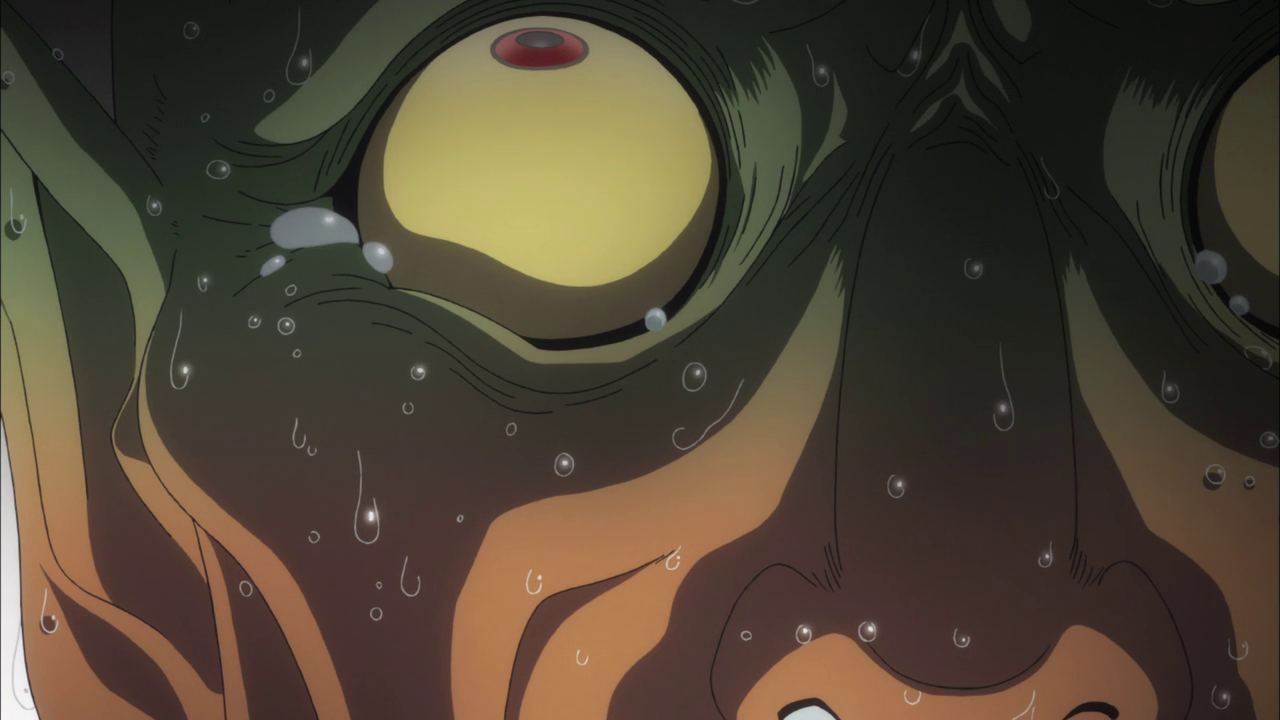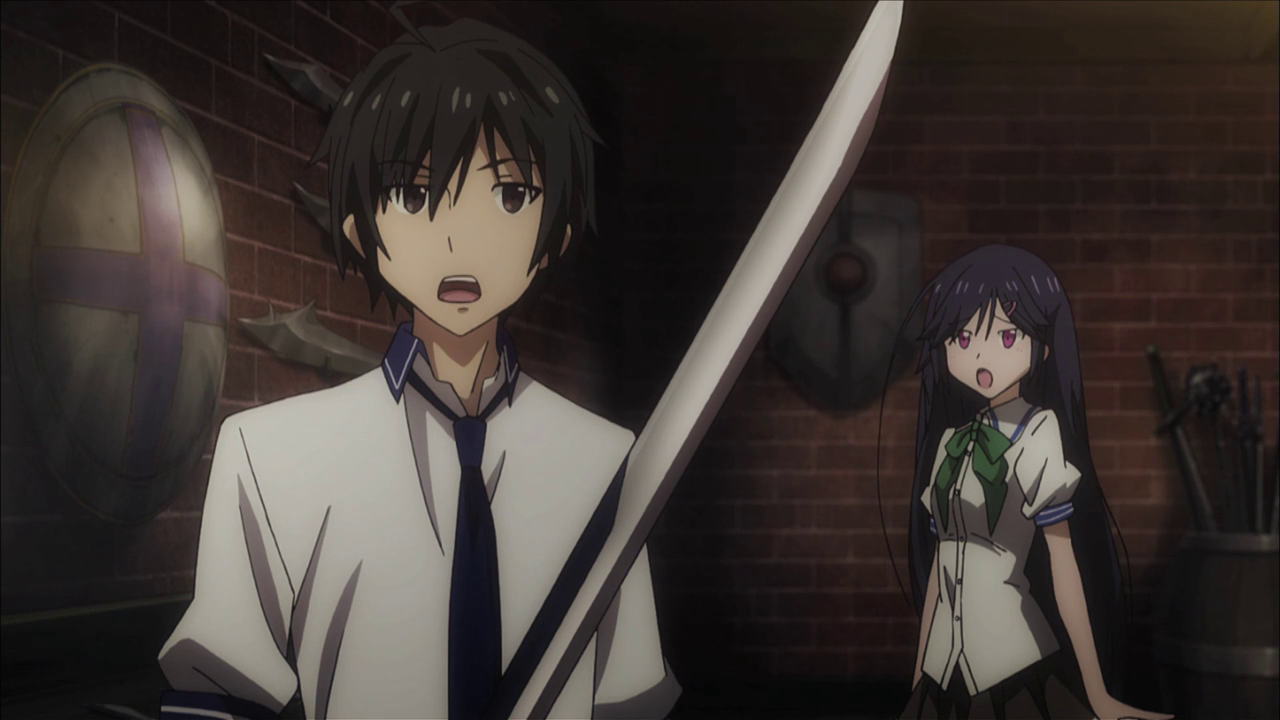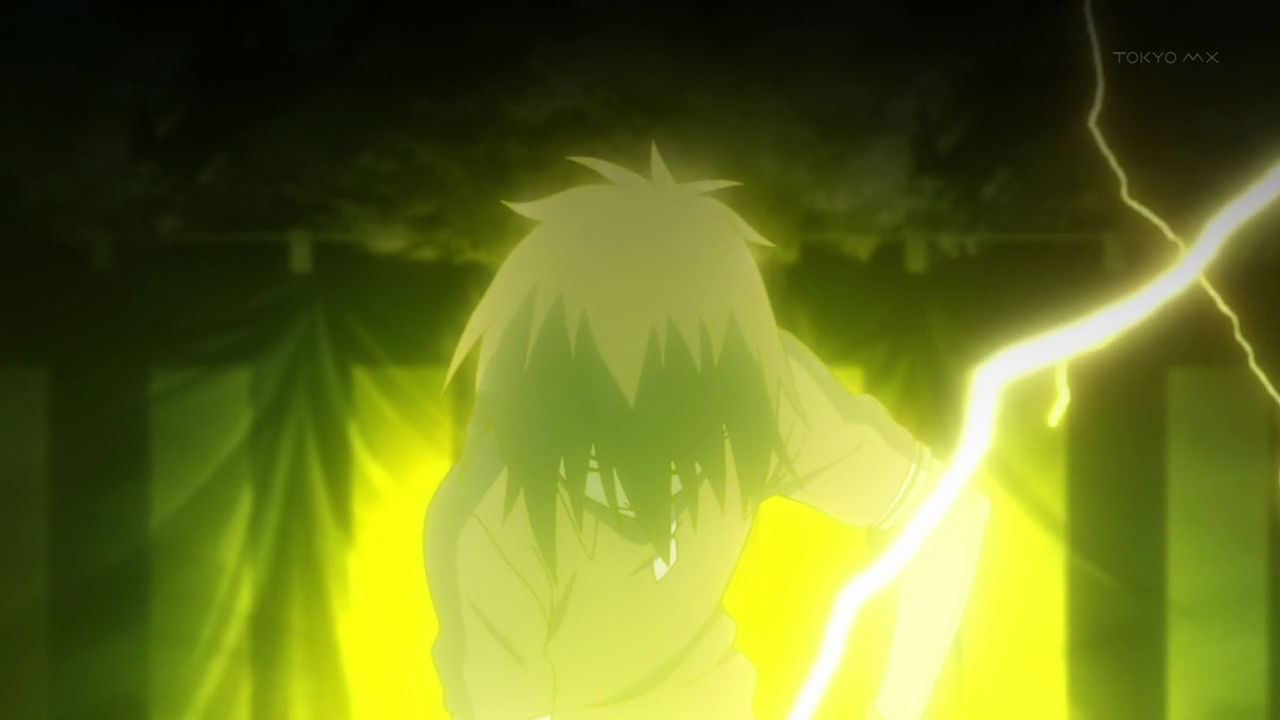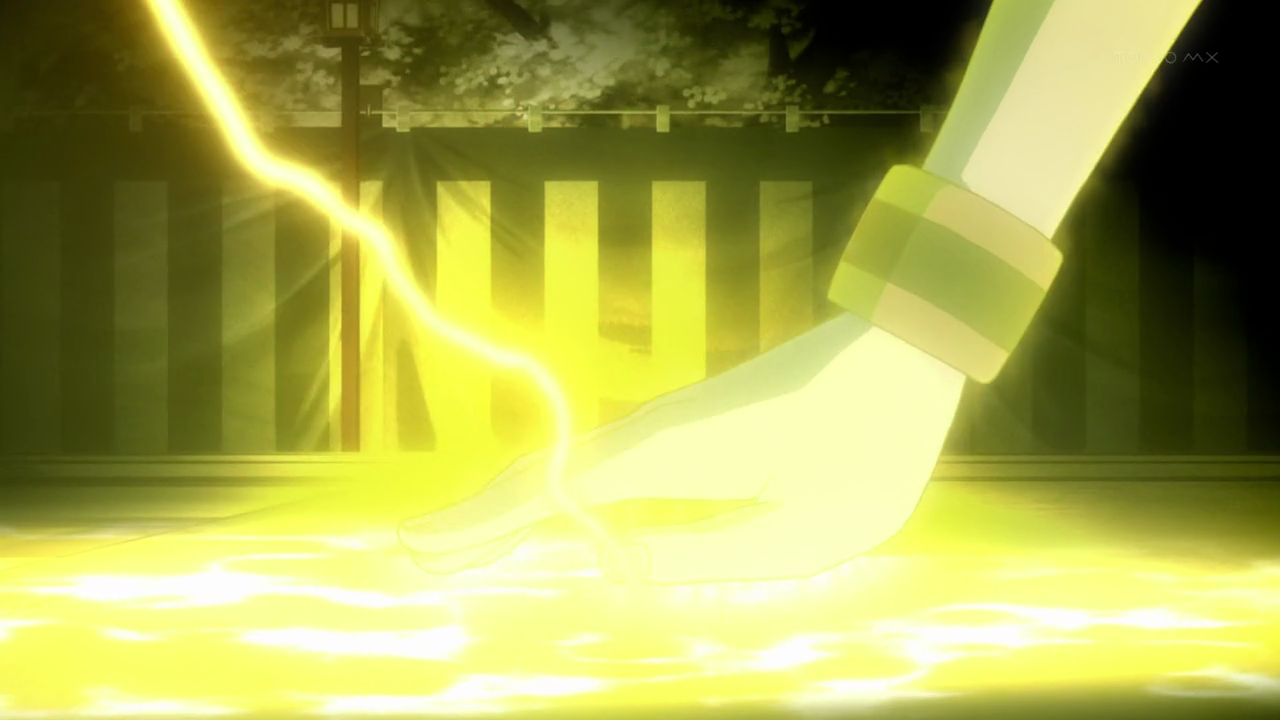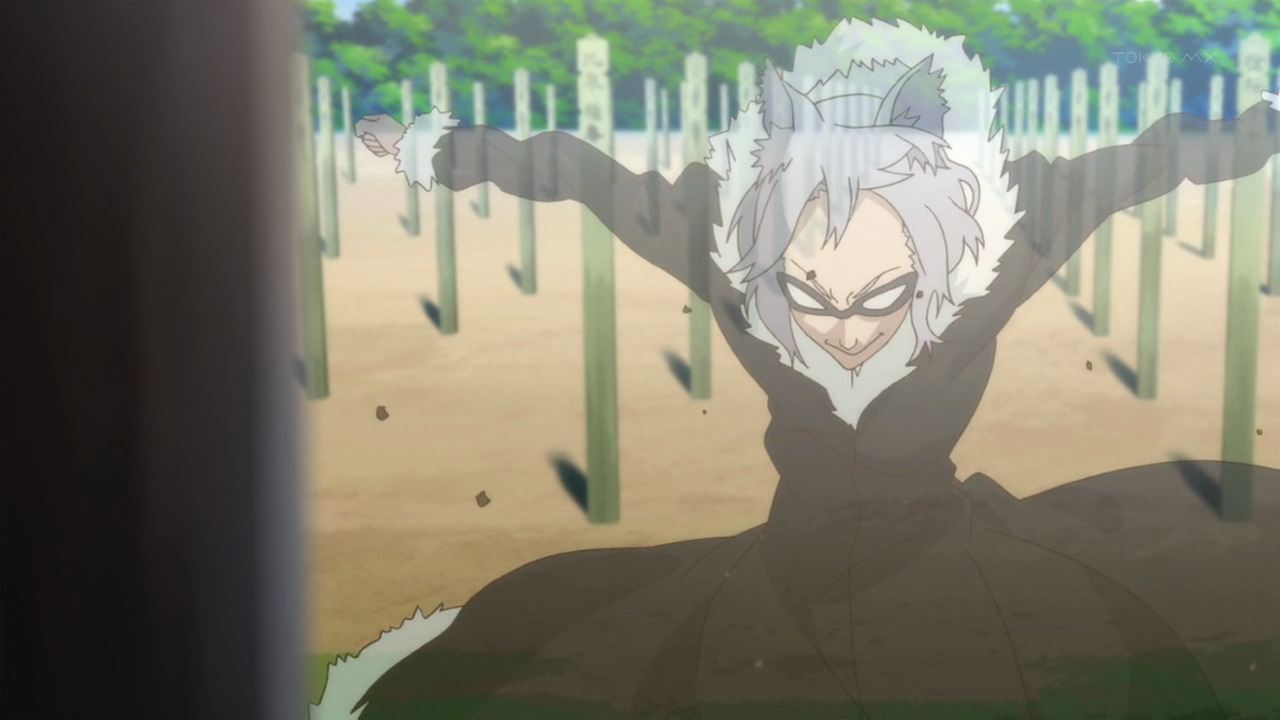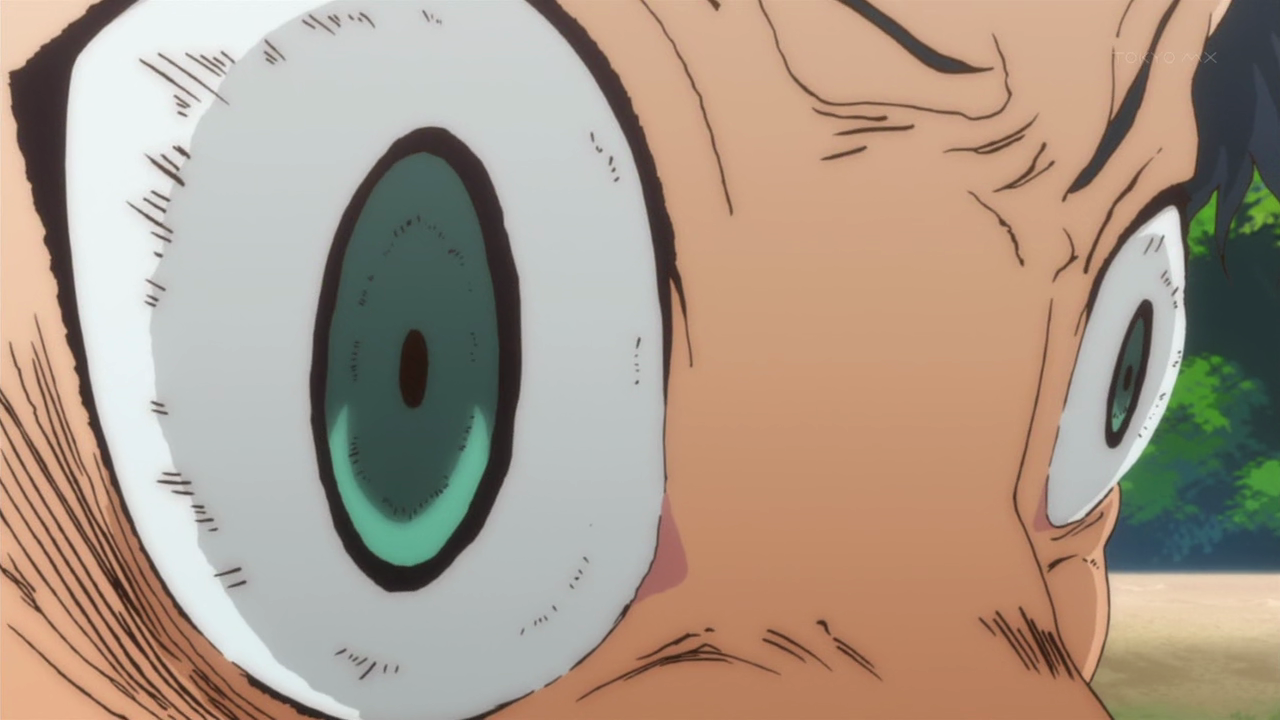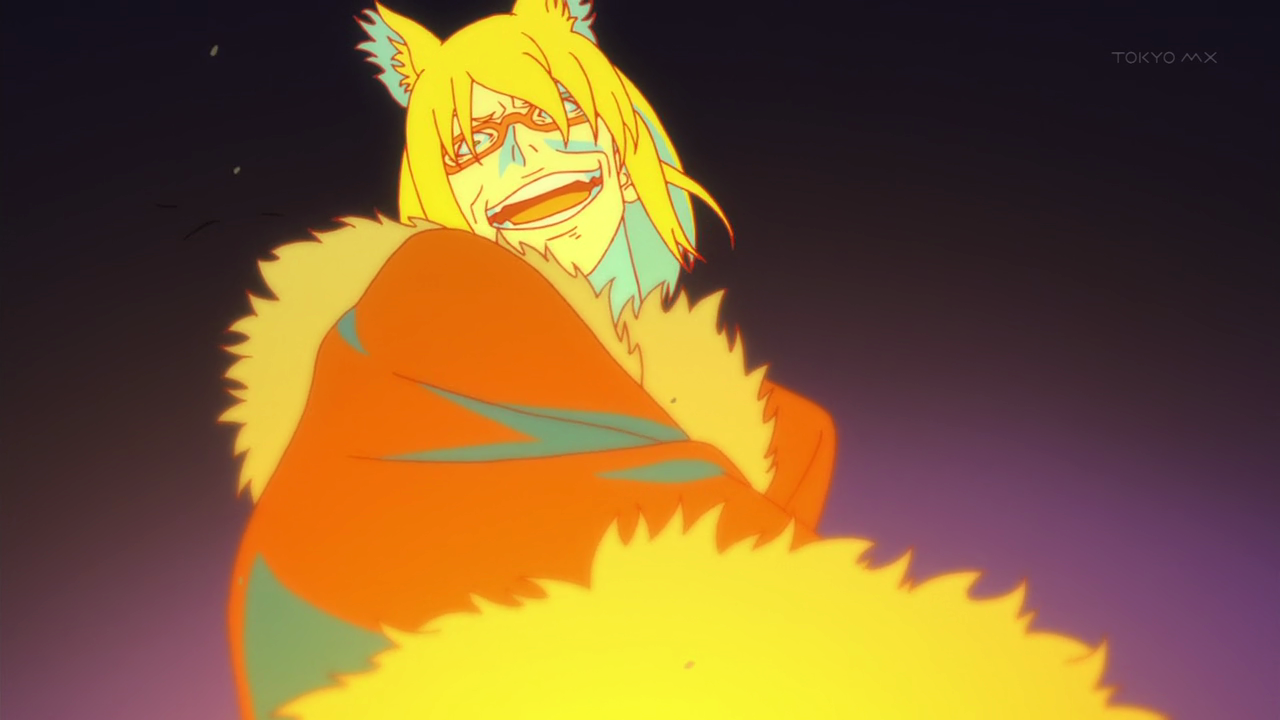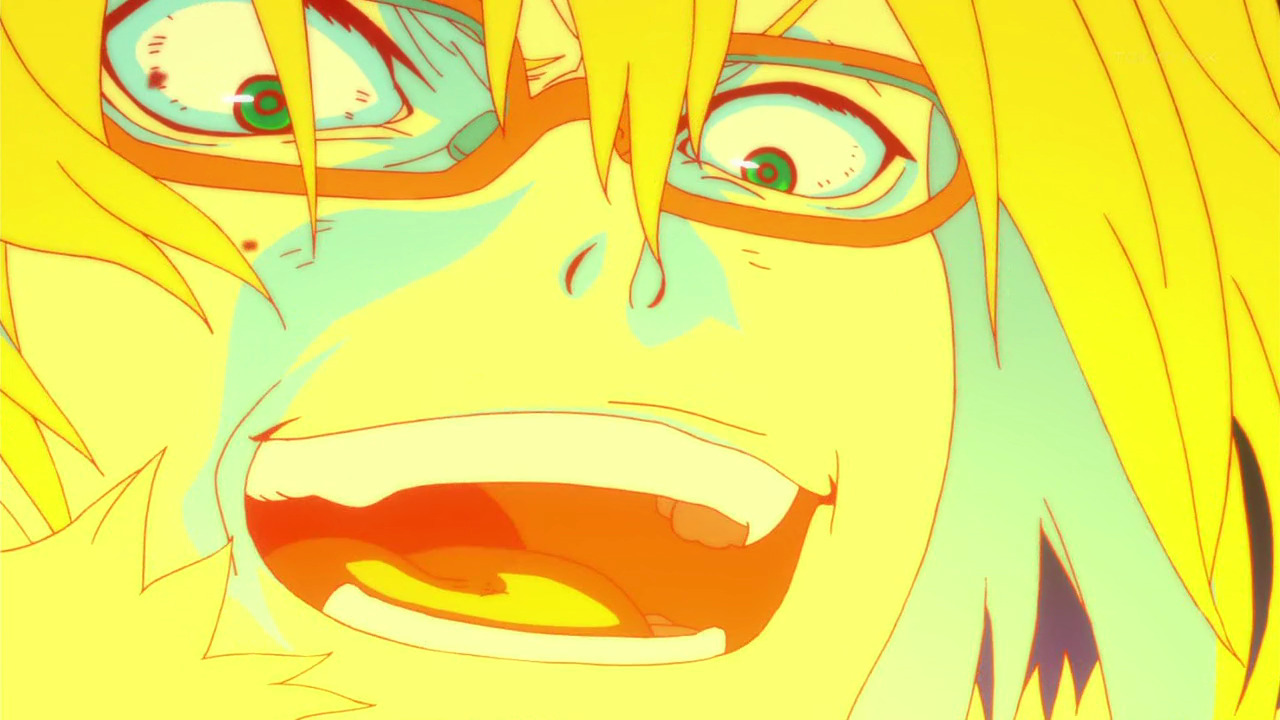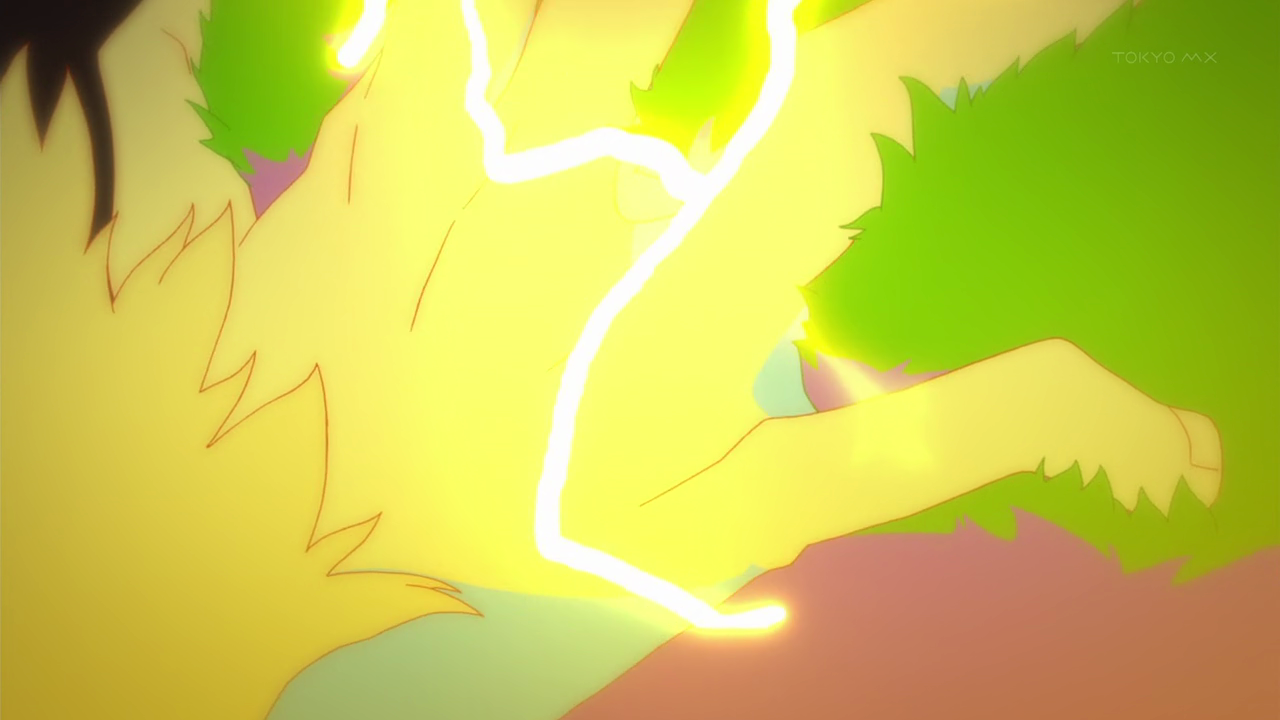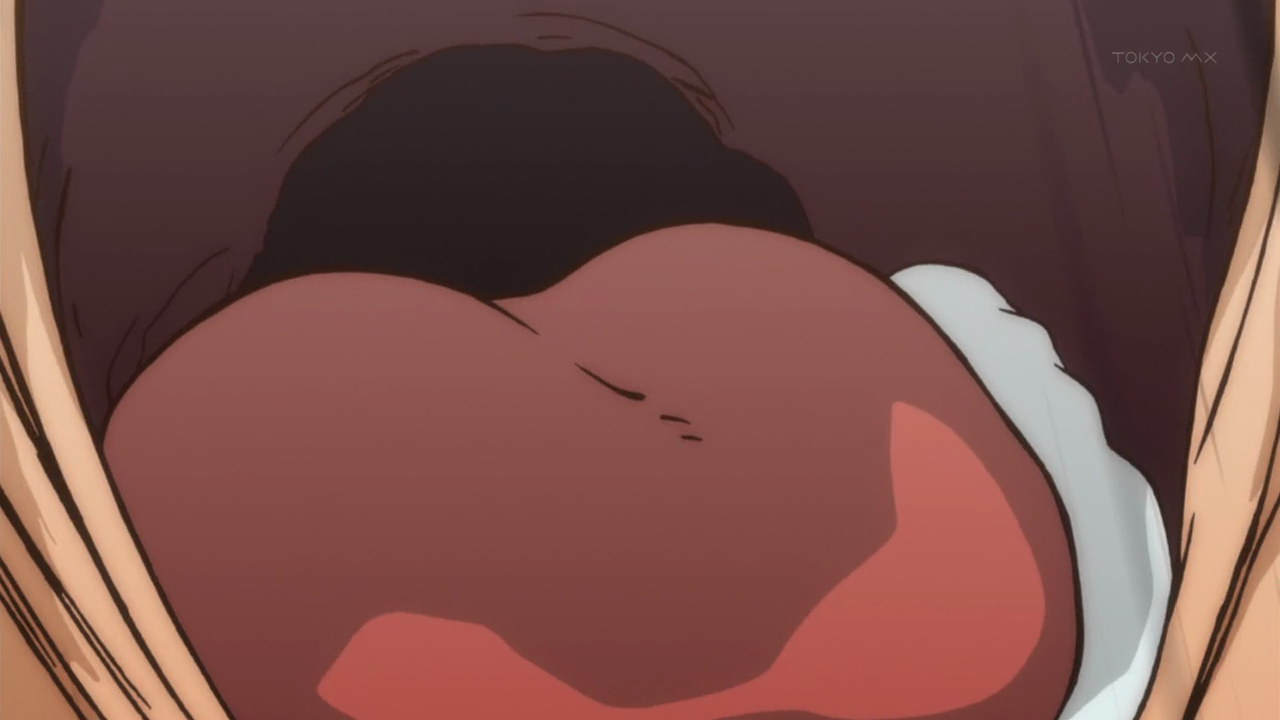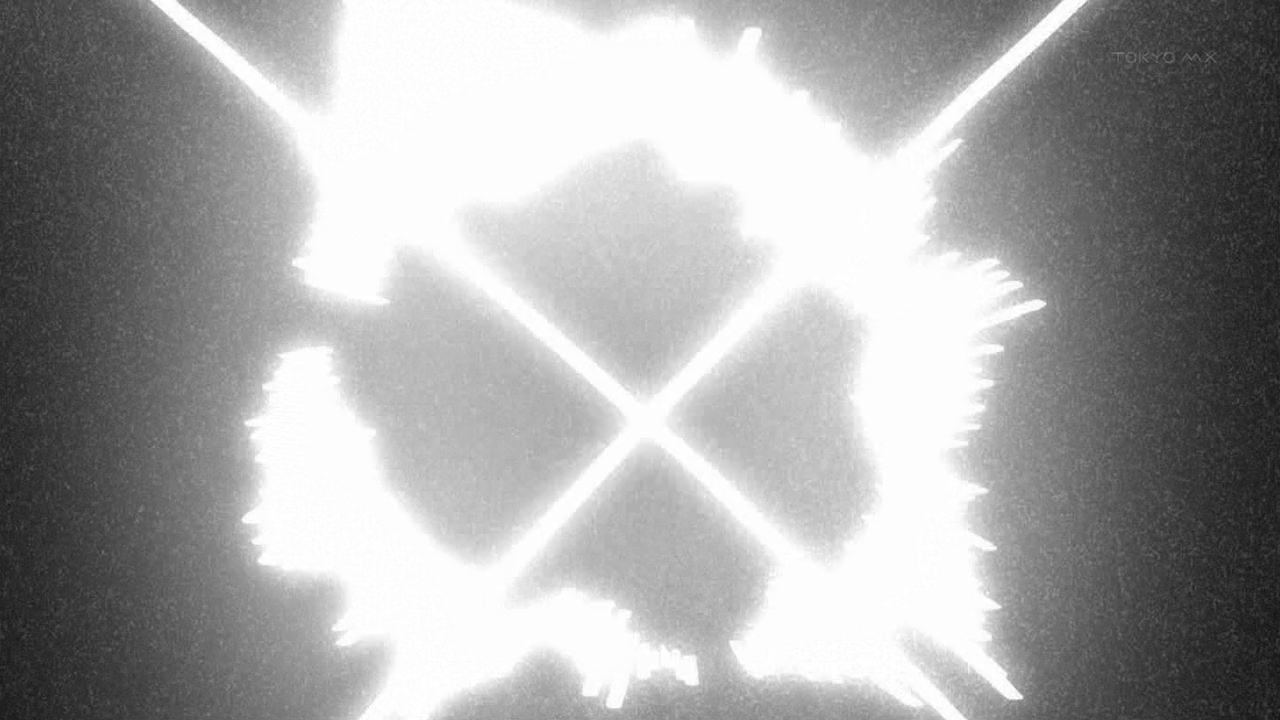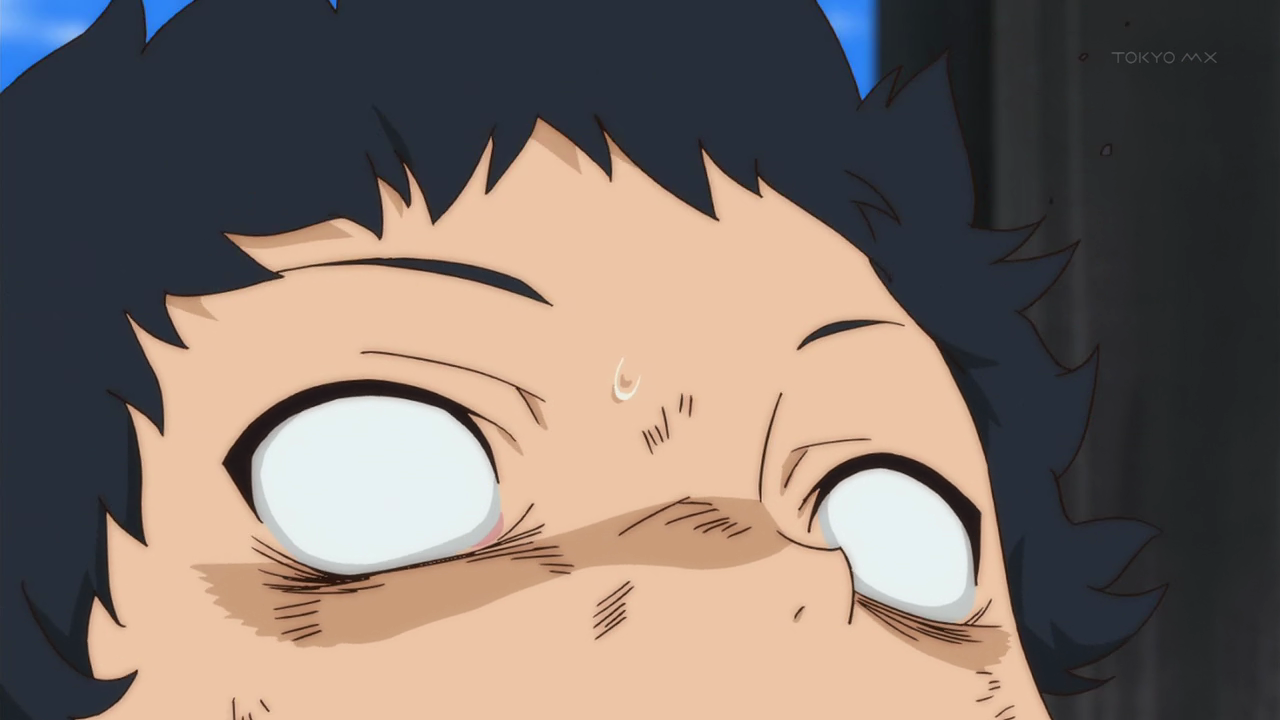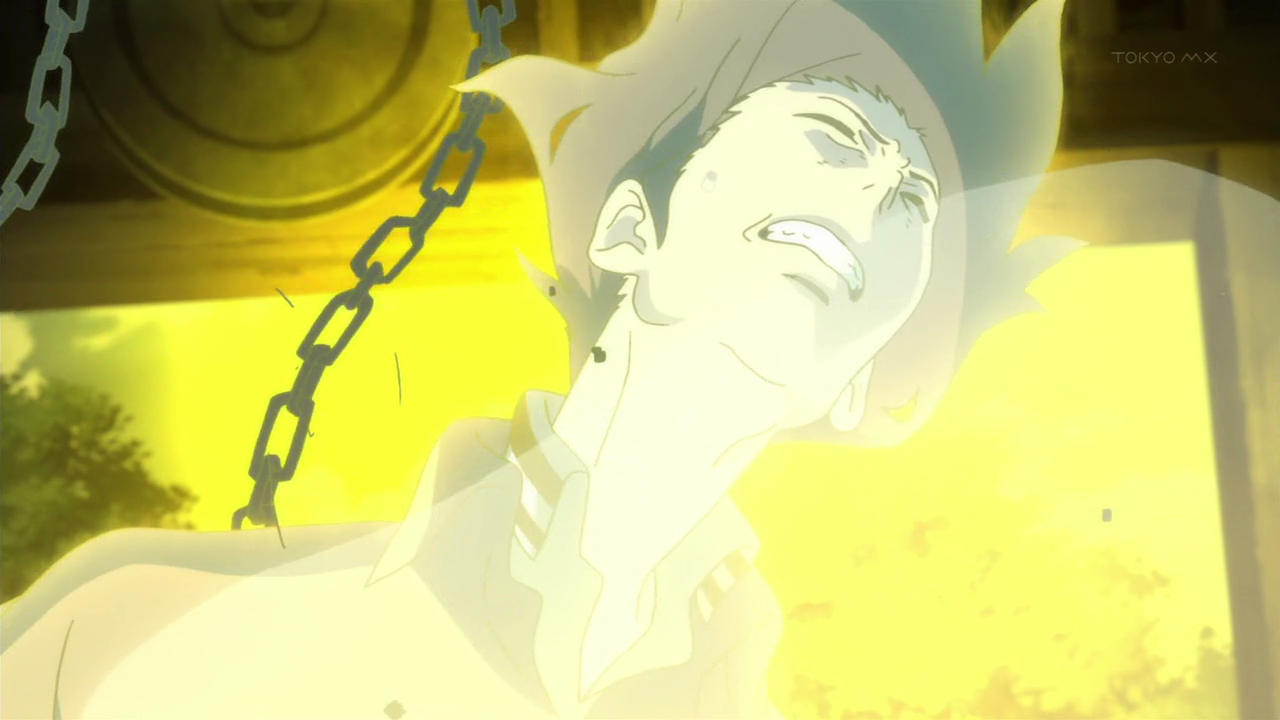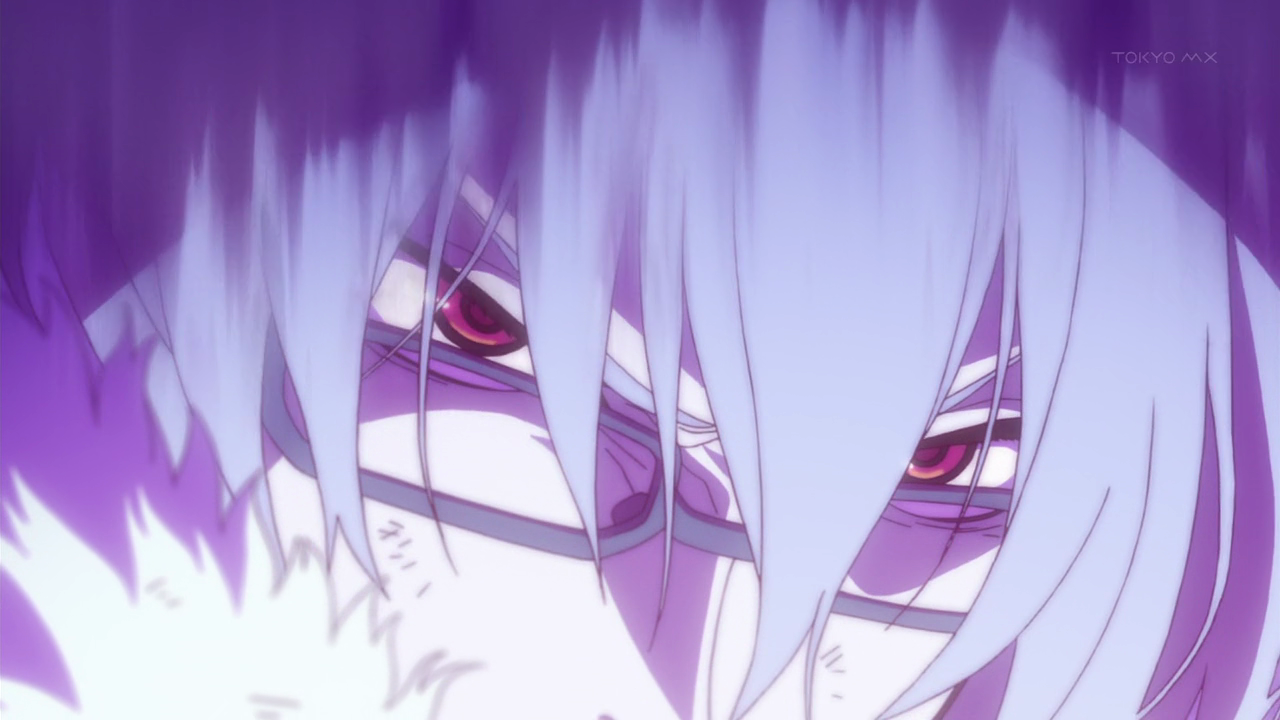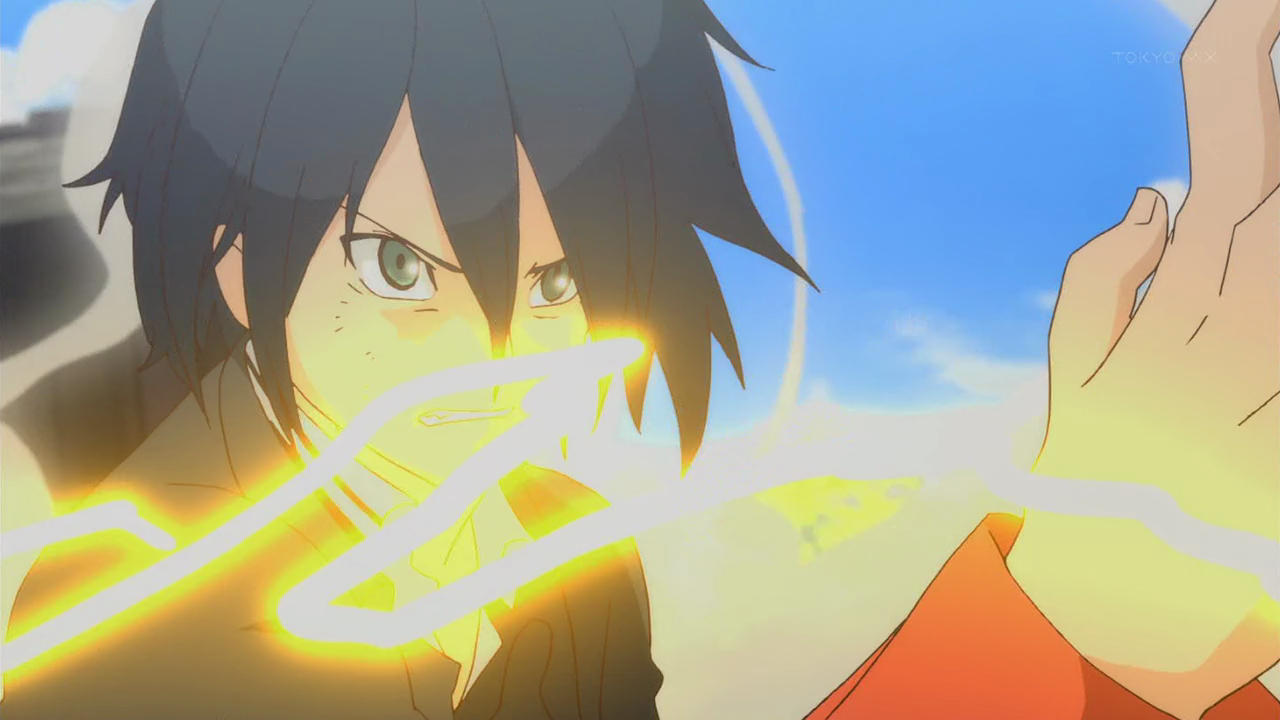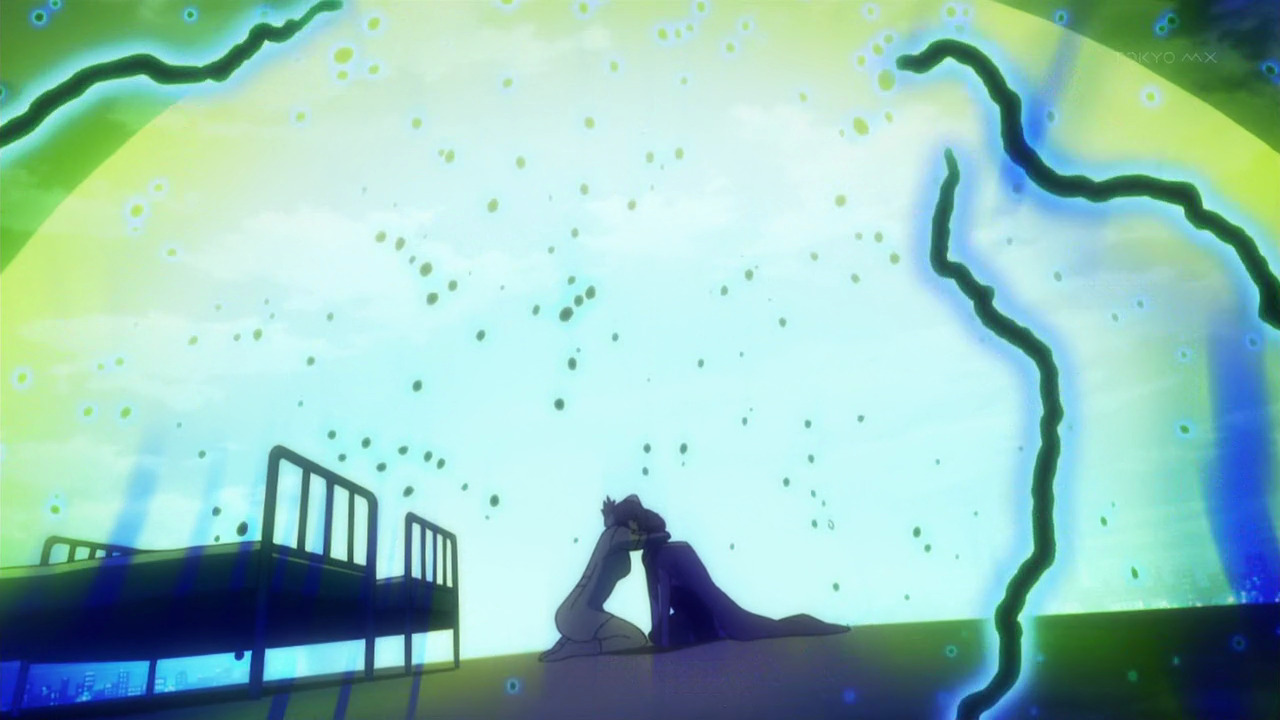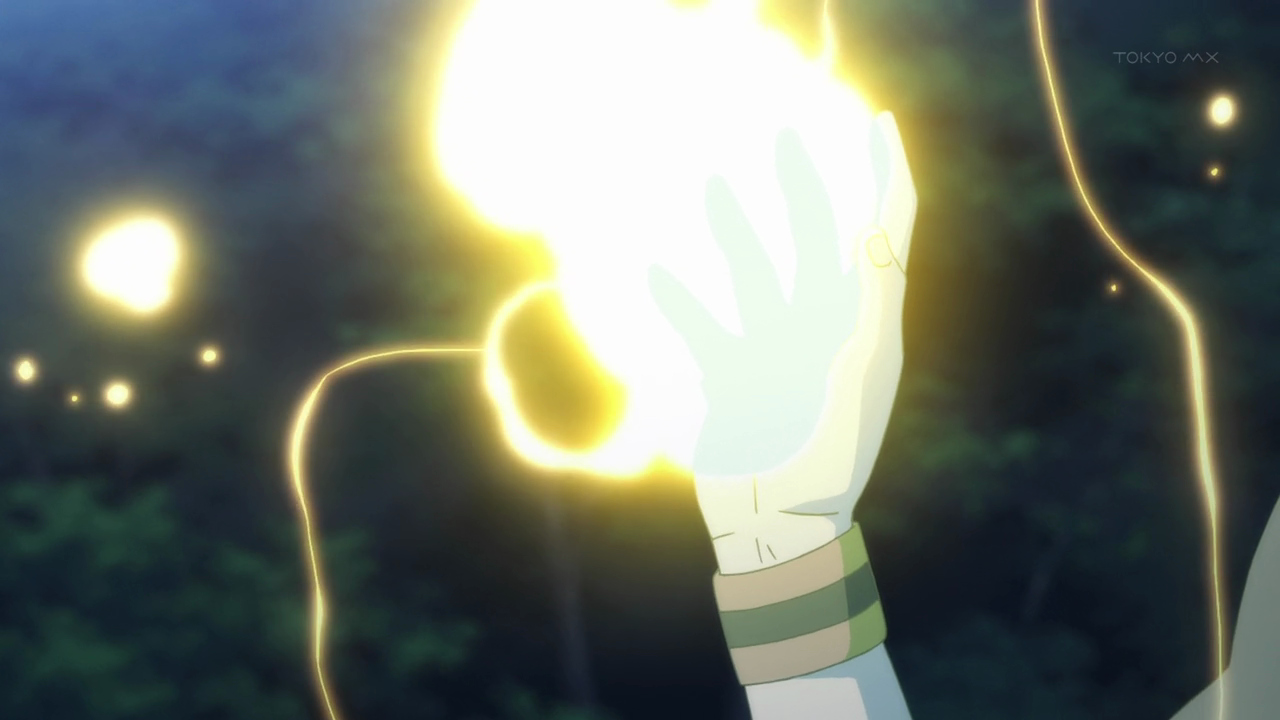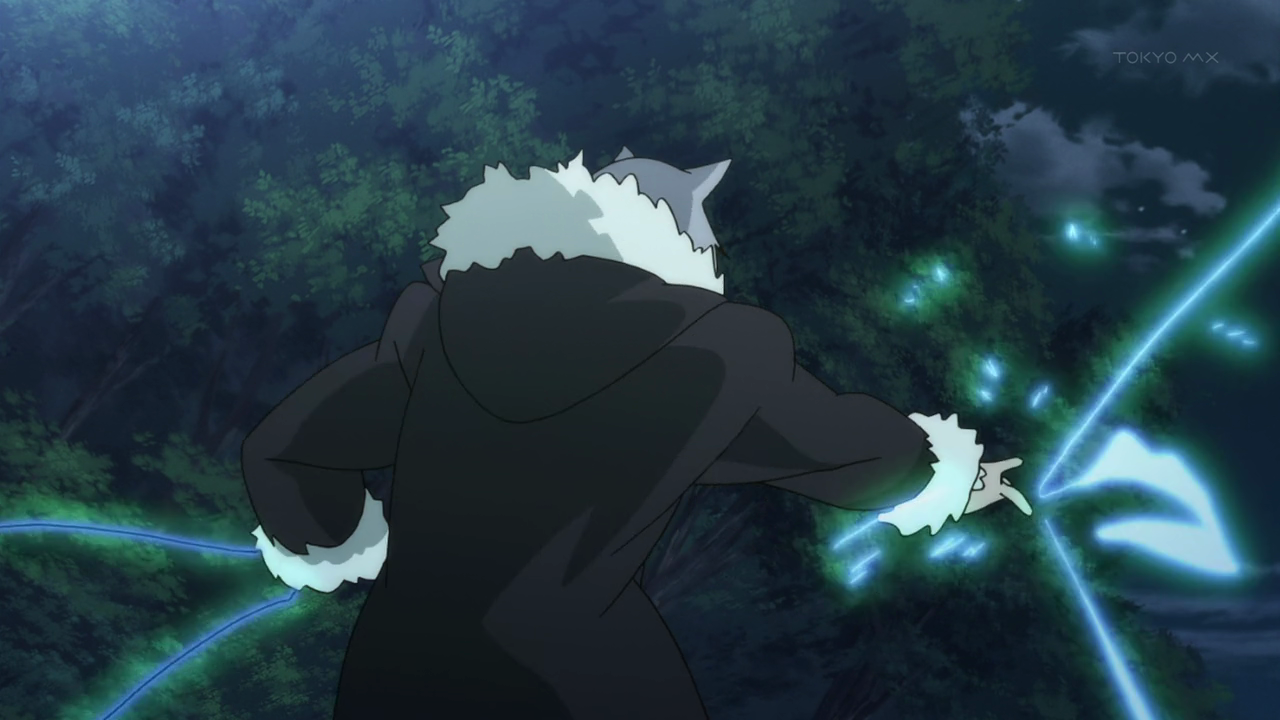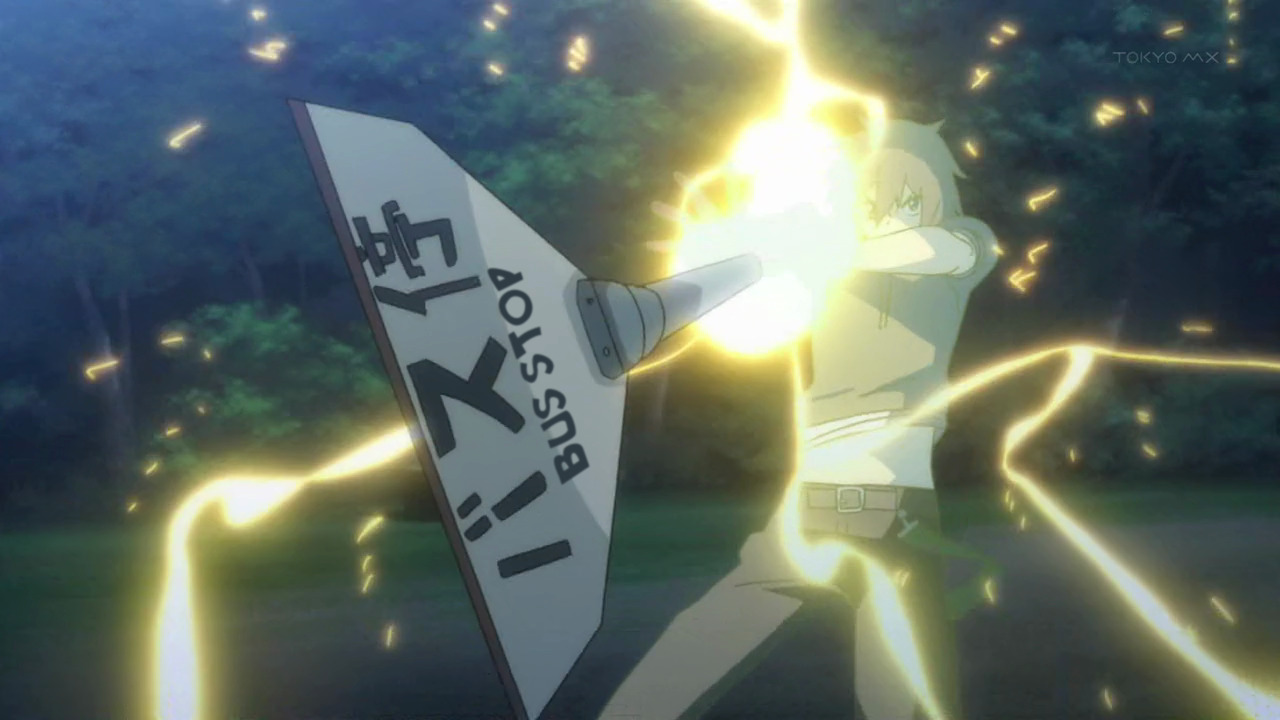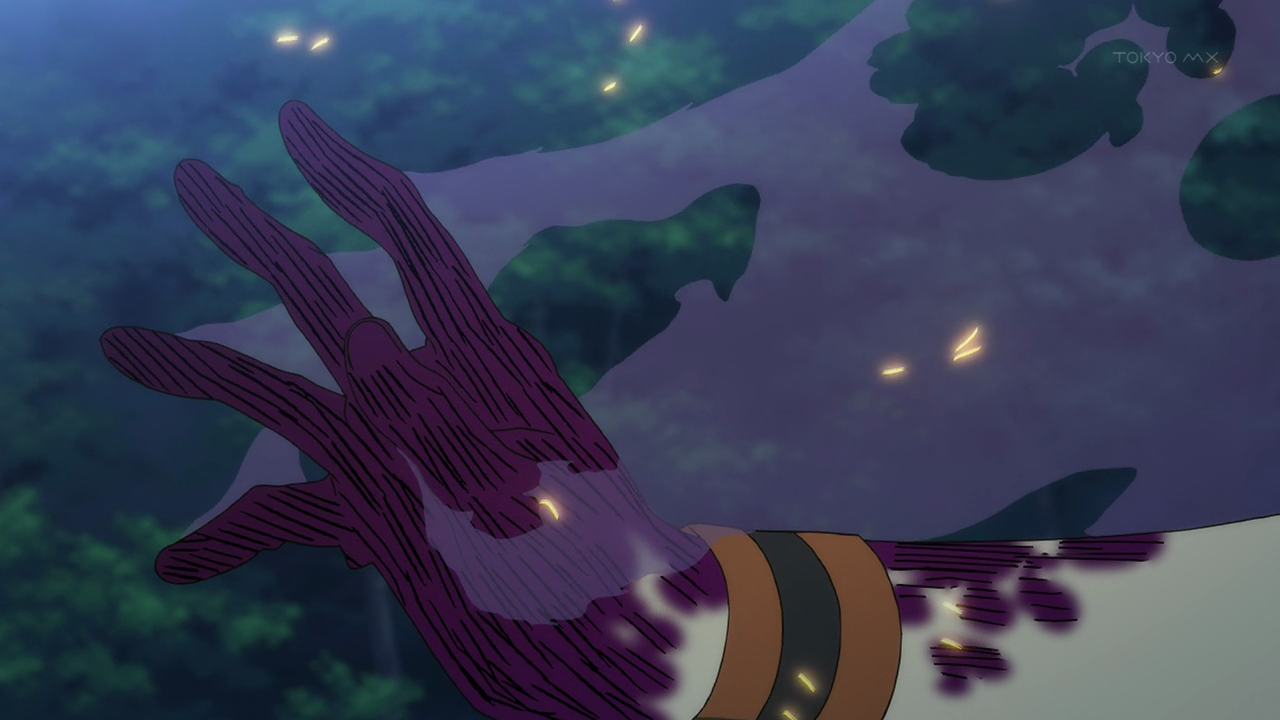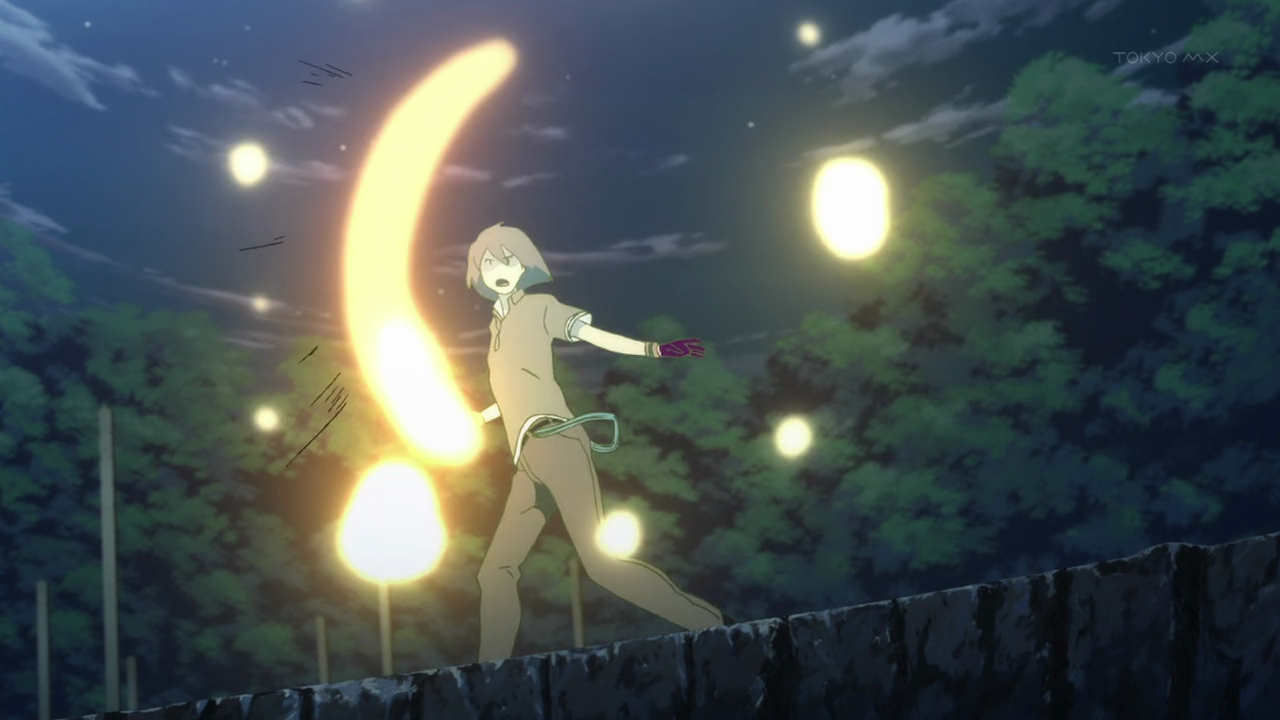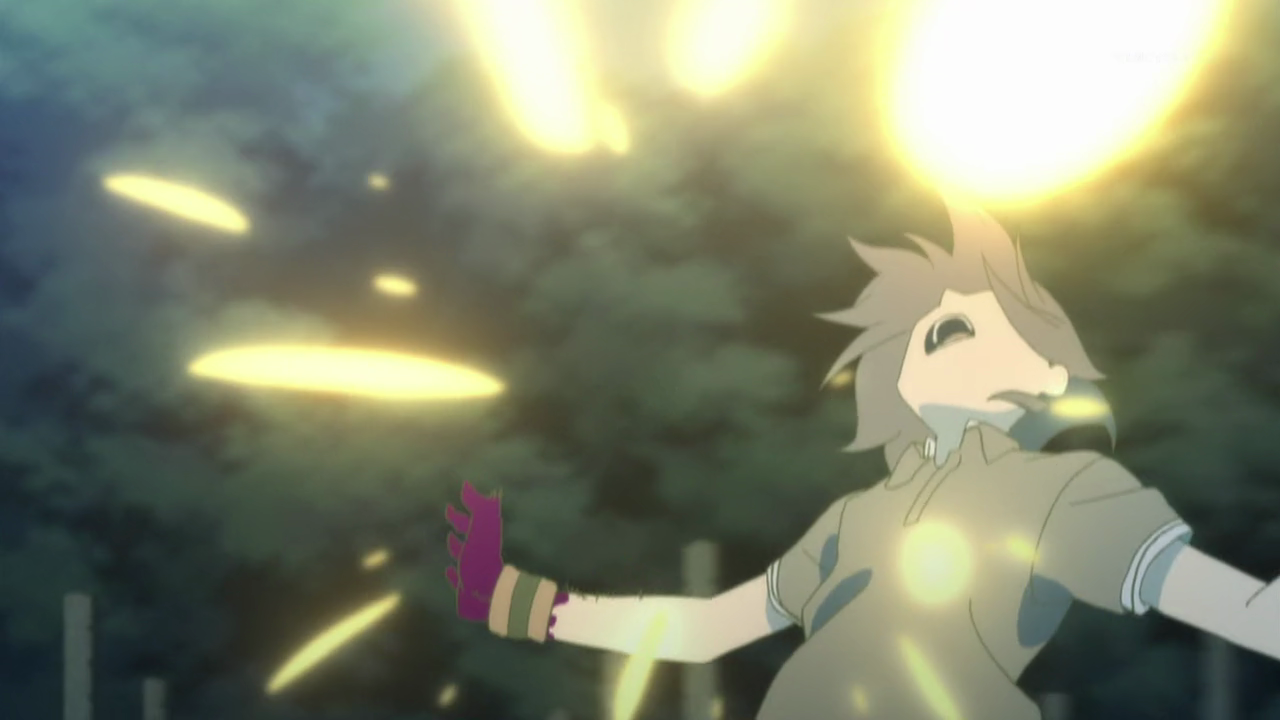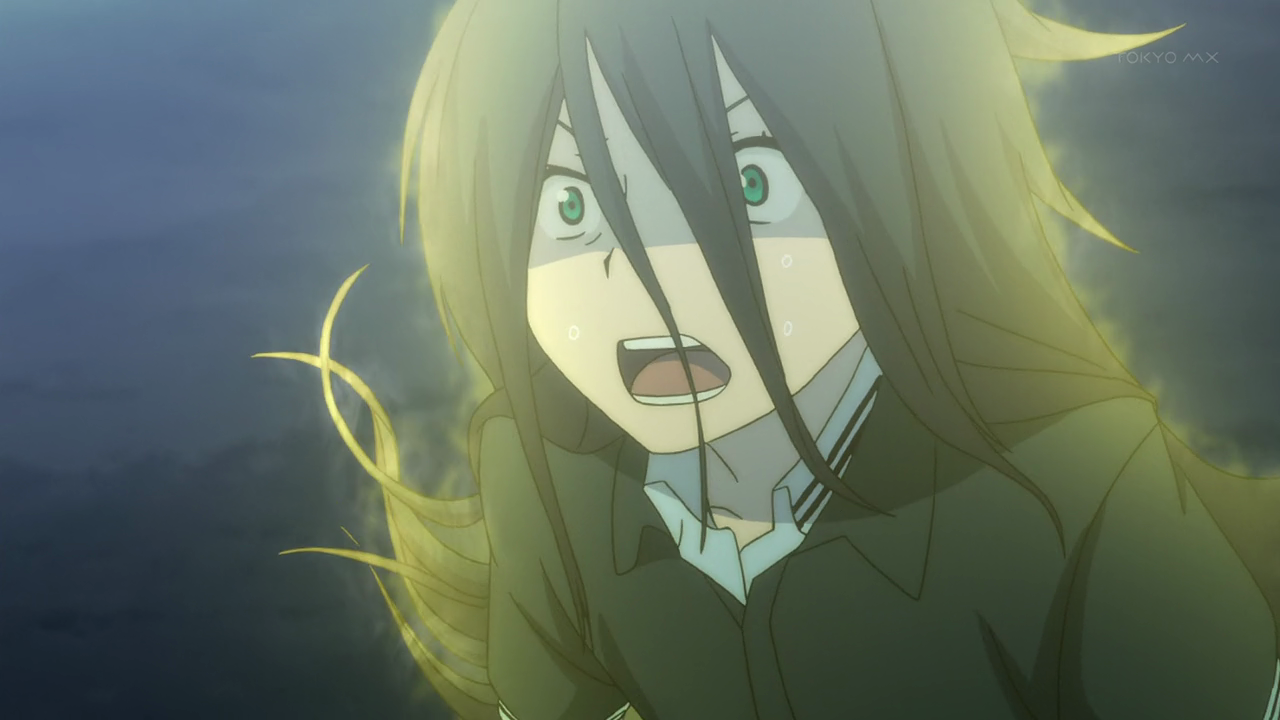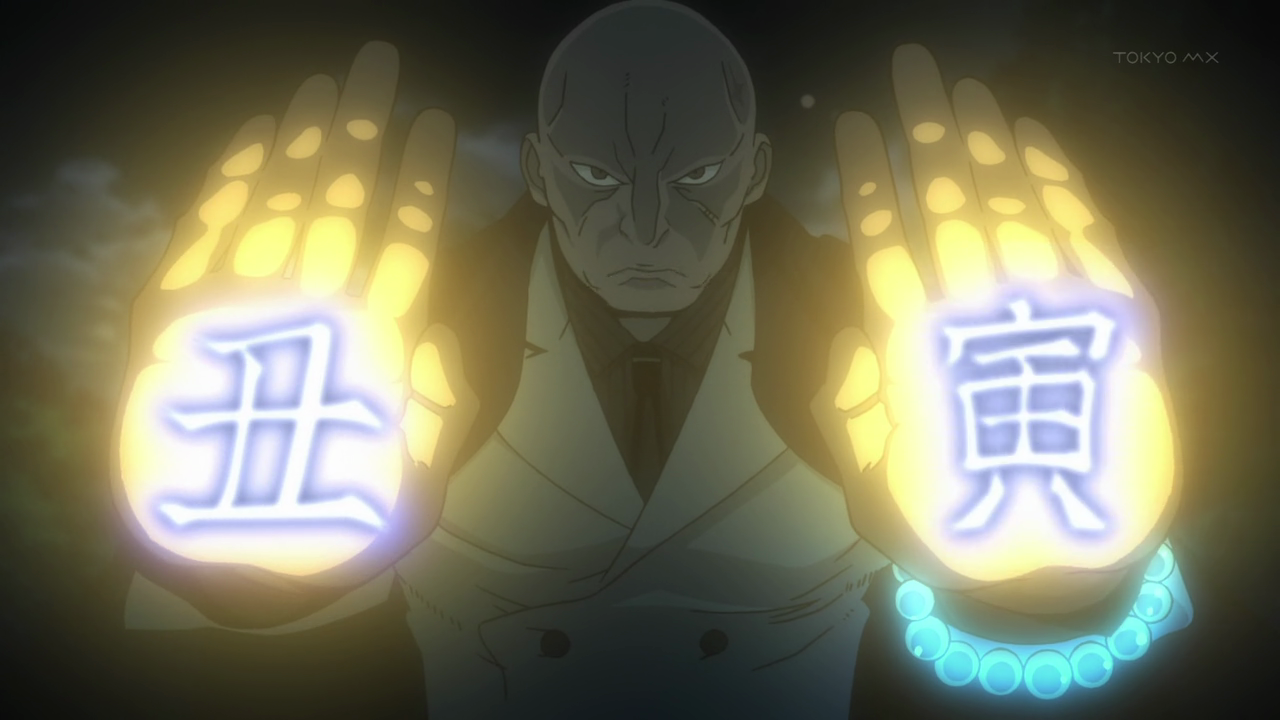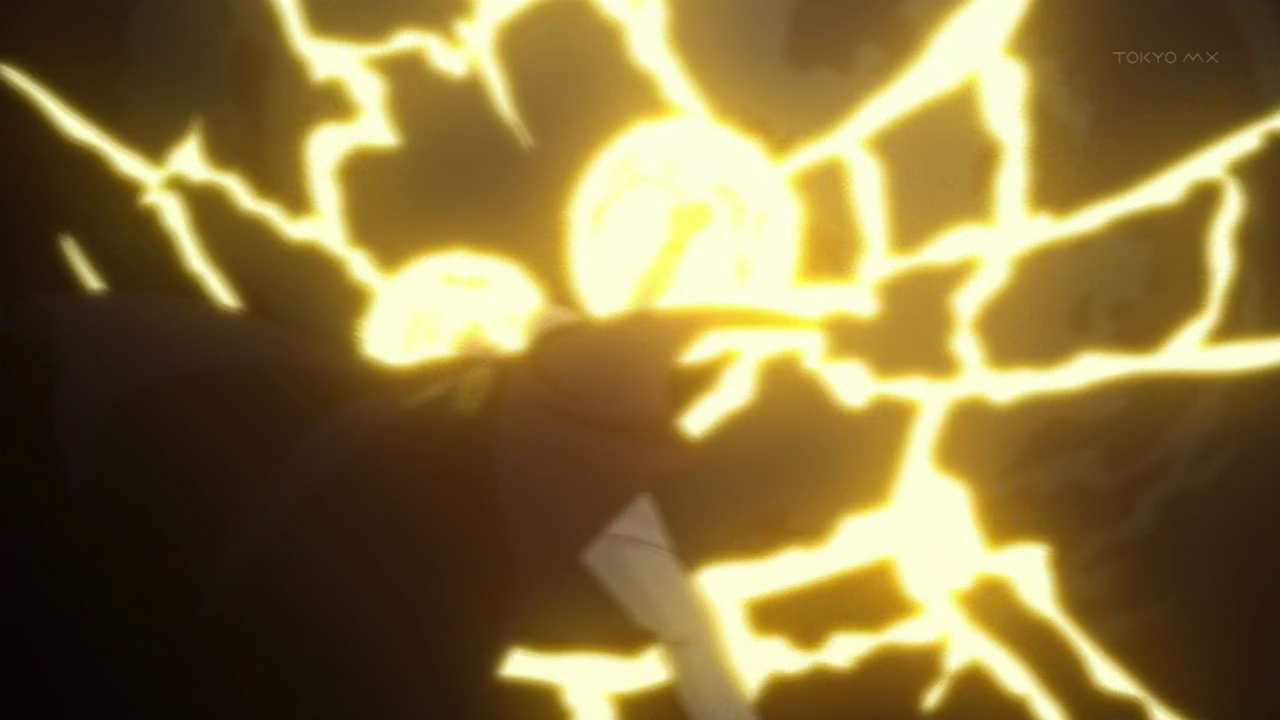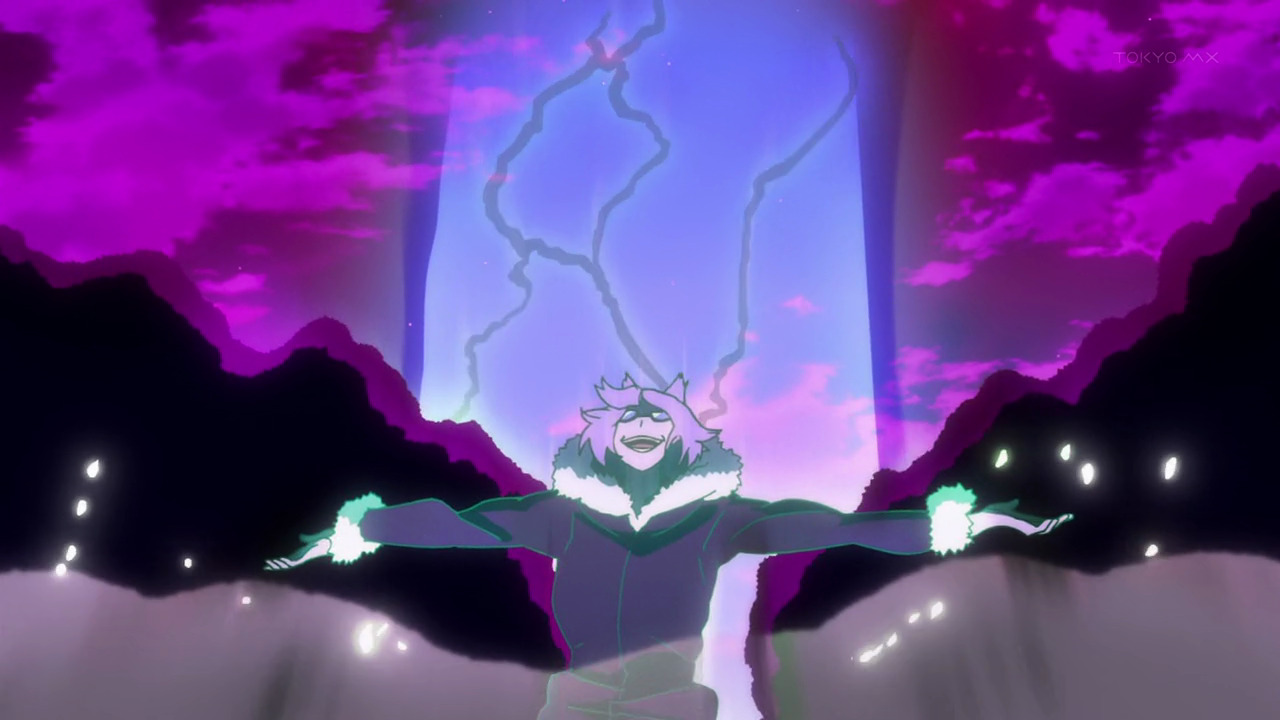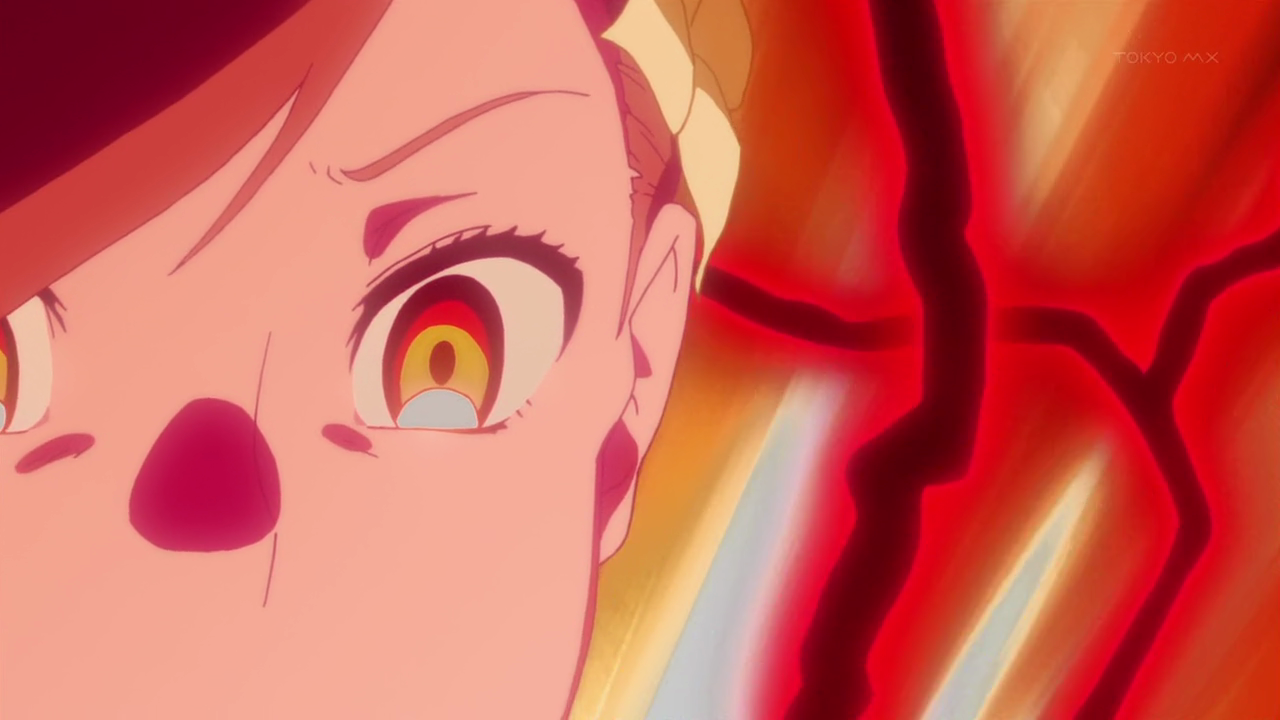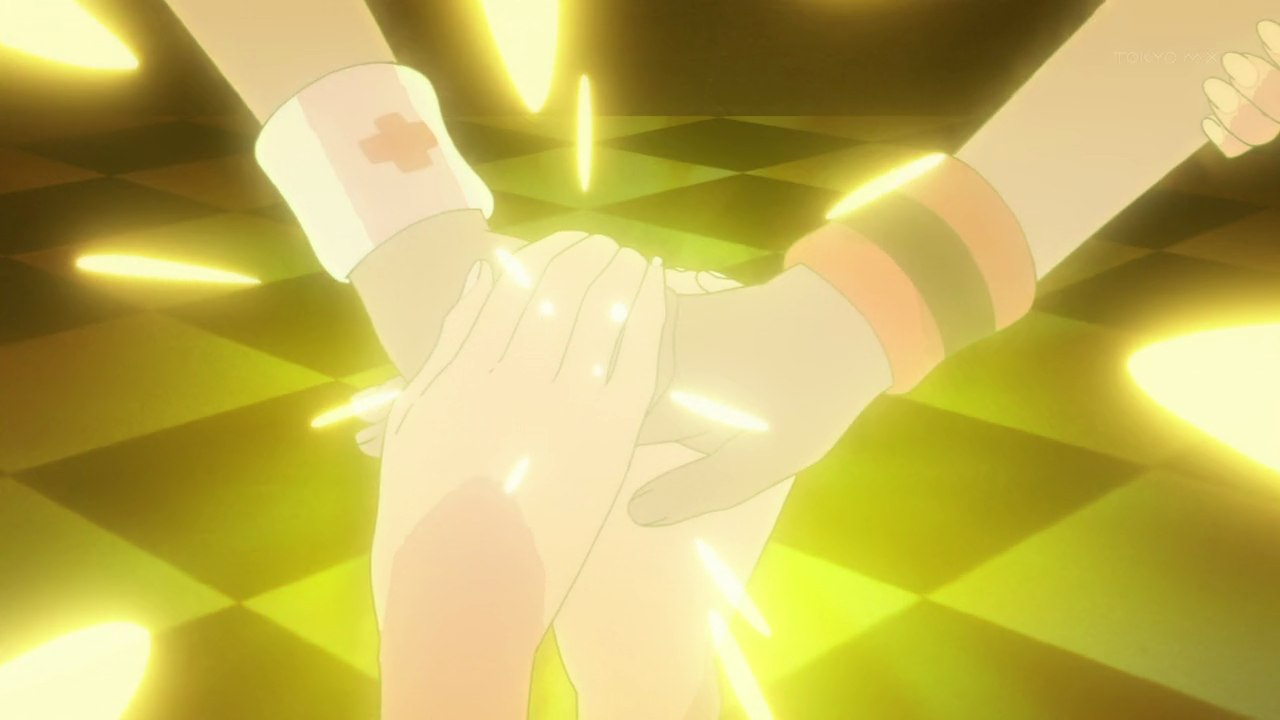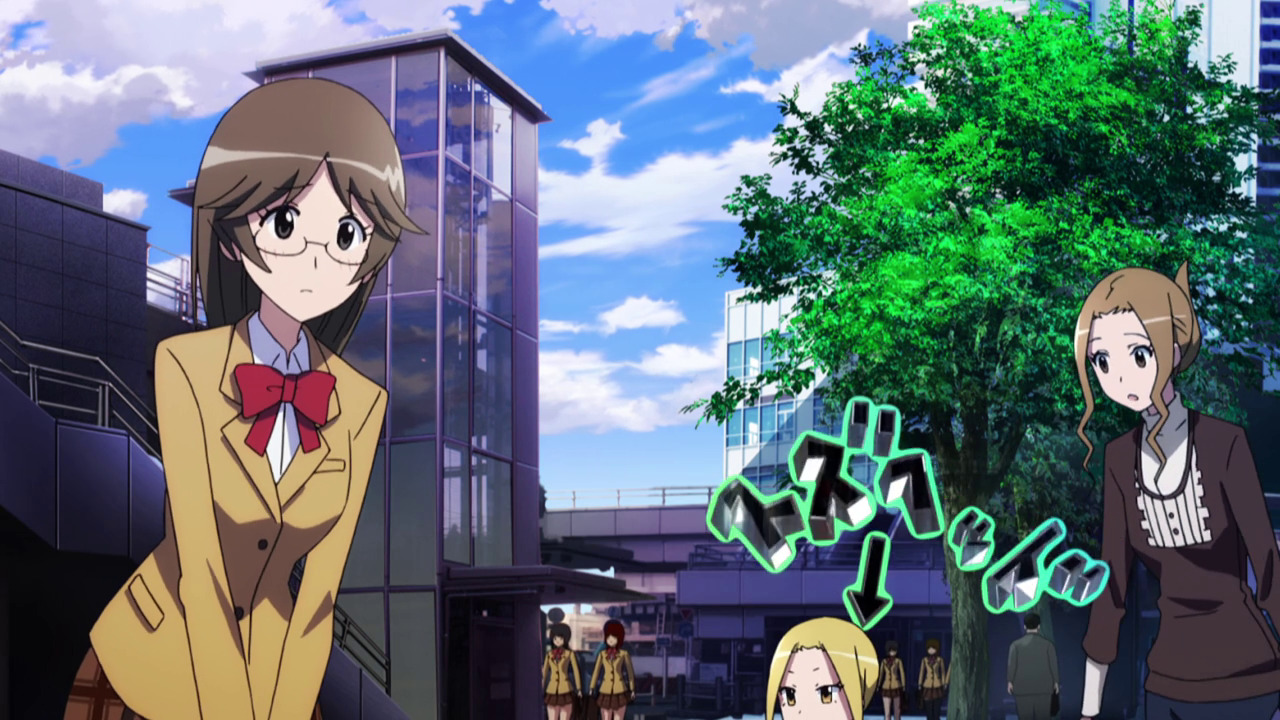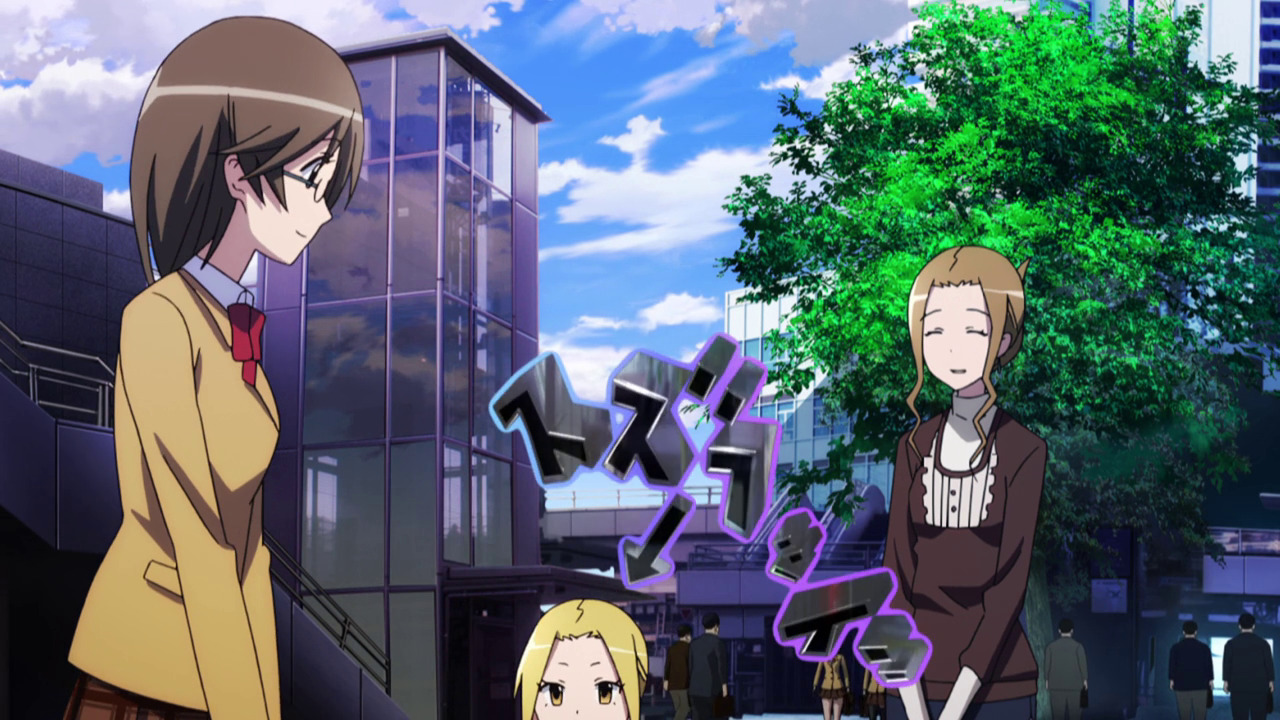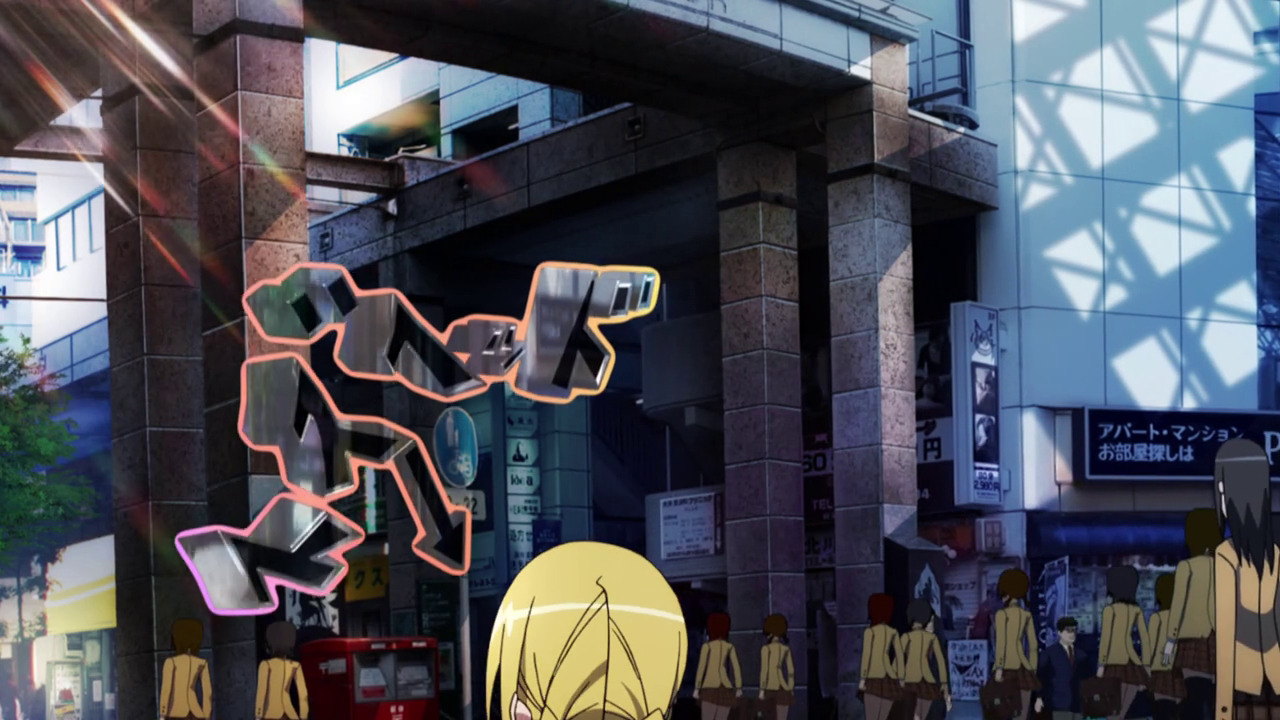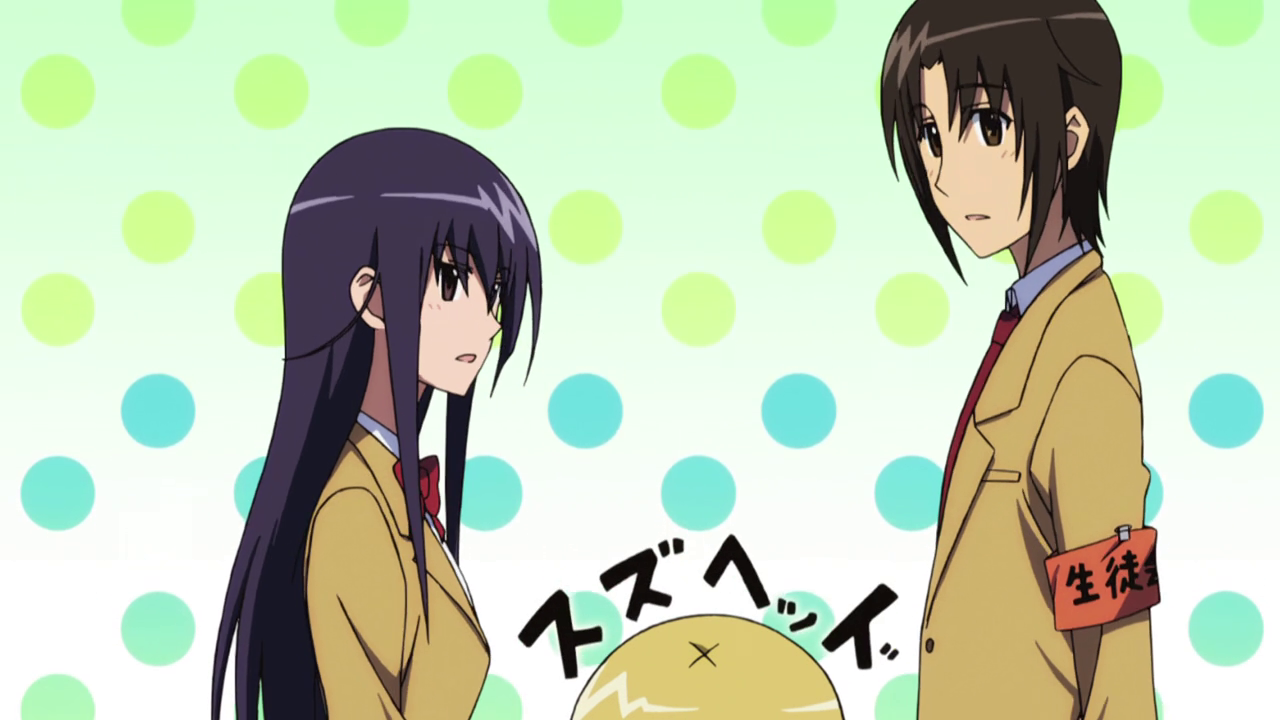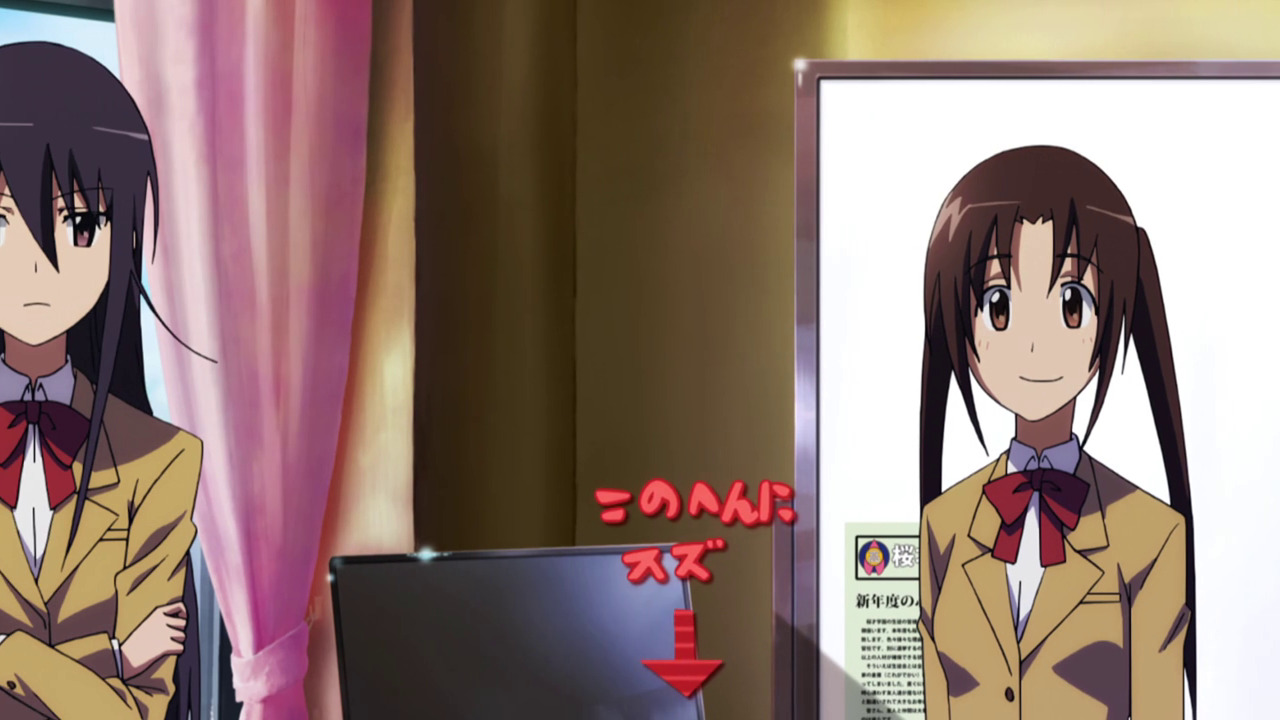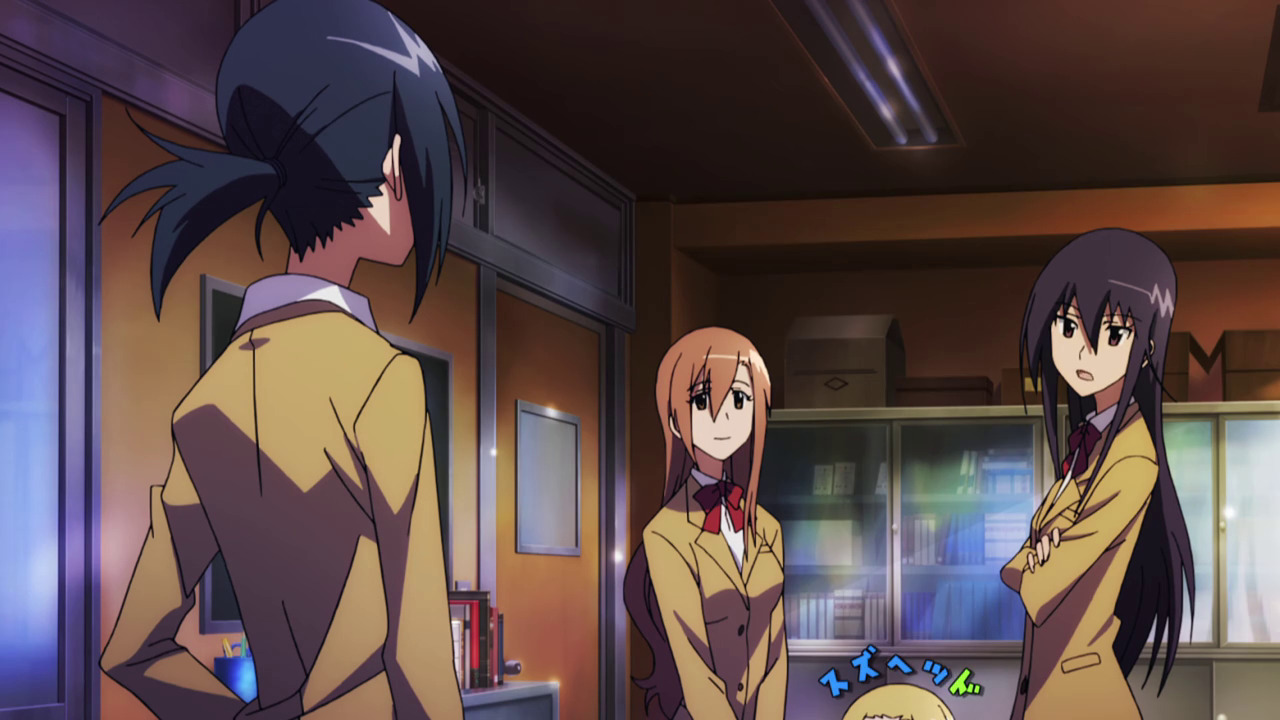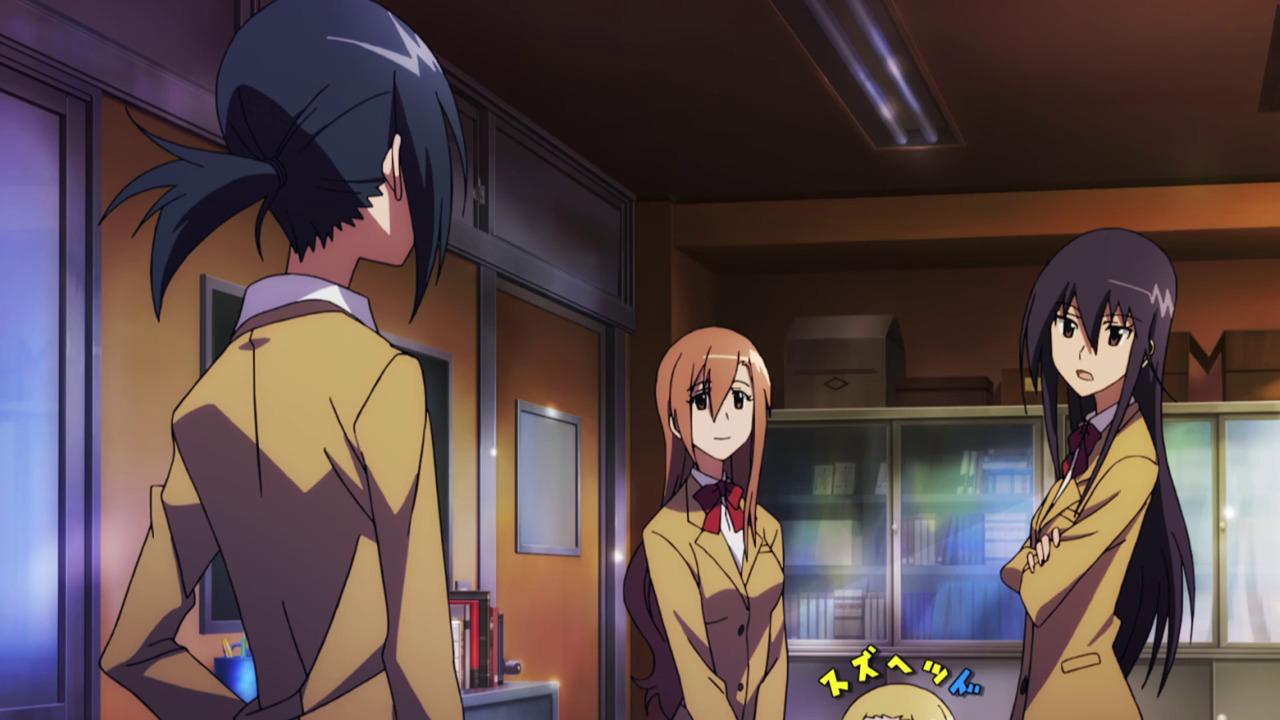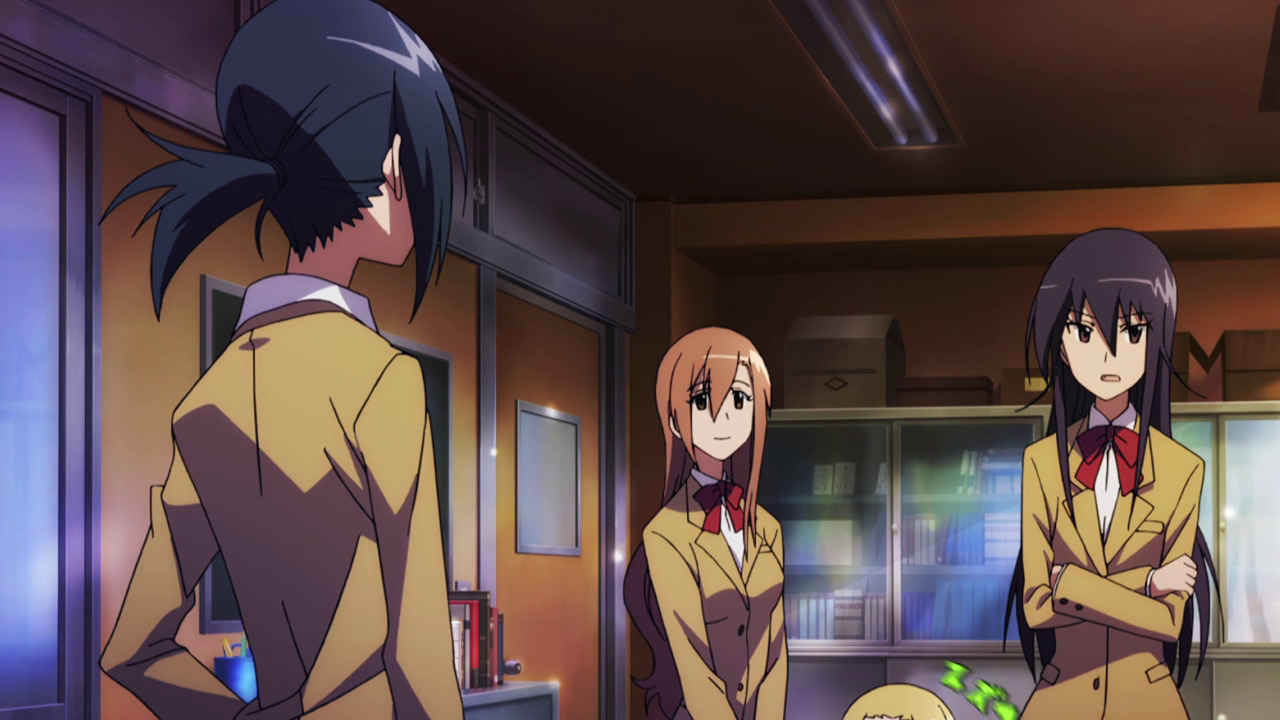The following are rated upon a rubric consisting of the standard aspects of consideration for completed anime series (art, animation, sound, story, etc.), but additionally accompanied by the evaluations of a premiere episode, such that its introduction to the series as a whole is vital in determining how effective a first episode it is. The following list is ordered by date watched and reviewed.
The rating system is as follows, from scores highest to lowest:
SS – Masterpiece
S – Exceptional ~ Near Masterpiece
A – Great ~ Wonderful
B – Good ~ Very Good
C – Decent ~ Pretty Good
D – Disappointing ~ Unsatisfactory
F – Something I have never given and hopefully never will
Full-length Series:
Seitokai Yakuindomo* #01.

Expectations: Relatively Low
Review: Considering their previous productions of K and Coppelion, it’s not like they needed to; but it seems as if Studio GoHands has rung in the new year with a fantastically admirable resolution of presenting an even higher quality of art and animation in their works. And all I can say to that is that I sure am glad this is the first series of the new year and new season I watched, because I am all but blown away and have effectively entered into a premiere-anticipating phase. Surely enough, I can say that that immediately, the beautiful visuals aren’t the only conspicuous factor to this gallant premiere episode, with the sound and music production alongside it accentuating the genuine atmosphere of an everyday school life, something that has instantly given the show a potency for depth that the aforementioned series were lacking, in my opinion. The opening sequence displays not only the just noted production values but also ingenious camera-work, particularly the unique angles that serves to introduce each character in a differing light, that eludes a very Durarara!!-esque presentation yet still retentive of its own flavor. Speaking of which, the show certainly does have one huge buttload of a cast, correspondingly to what one of the character says, “There’s enough of you there to have an orgy.” And although I’m sure we won’t be seeing an orgy of any such kind in the entirety of the show’s runtime, despite the bizzarely, seemingly natural, blending of promiscuous jabs, jokes and general dialogue (I think I counted the mention of the word d**ck at least five times and then of course the actual depiction of a censored one in the opening), this lot of characters certainly seem like a united front that can deliver one fine account of adventures, or the more likely misadventures. In discussion of the company, I don’t think it would be fair to disregard the underlying, almost meta-fictional two, they being the dog and the narrator, who doesn’t actually narrate via words but rather by interlaced titles. These two considerably give this premiere episode the effect it has: the dog being a frequenter in sharing its visual perspective (though with the color-vision we human viewers are familiar with, how great is that?), and the narrator sharing his or her own inter-bound world, which it treats as, for lack of better comparisons, a variety-show of sorts, foreshadowing the lewd wisecracks the character will make, recoiling in surprise when miscalculating the delivery of said gags, and even self-acknowledging foolishness about forgetting to introduce a character. And yes, indeed, this narrating being is quite a fine representation of the tomfoolery, zaniness, lunacy, nuttiness of the series itself. In the end, what can be said of the show from this premiere is that its a nonsensical, almost paradoxical (even the OP has worse art/animation than the actual episode content and that’s just unbelievable by anime standards) blend of a youth-oriented high school life premise, fascinating production values resemblant of a movie suited for more mature audiences, and vulgarity in content more strapped for much, much more mature audiences; each aspect verging on undeserving of the other two. Frankly, I’m not used to such a low-key series sporting such brilliance in execution; but what I would love to be used to is for this tier of aesthetic to be the established standard for all series, so I unmistakingly commend the series for shaping this path.
Rating: A-
Saikin, Imouto no Yousu ga Chotto Okashiinda ga #01.

Expectations: Relatively Low
Review: Japan’s exhibit of the little sister complex, and the anime industry’s obsession with it, continues with Project No.9’s adaptation of this quaint love affair. As one of the characters denotes within the first ten minutes while elaborating on the need-to-know distinction of younger sister and younger step-sister, there’s more depth to the imouto sub-genre than meets the eye. Saikin, Imouto no Yousu ga Chotto Okashiinda ga, or ImoCho, is also a pretty specific mark on this spectrum of imouto. I may have sad quaint before, but perhaps that may be a misleading descriptor without fair amount of elaboration. While ImoCho is ratherish convenient and lazy in its premise, wherein newly consummated siblings are left home alone by their parents and what’s more an angel forces the titular sister to quite literally become hot and bothered by her brother, that elicits suggestive and carnal complacency; at the same time, it’s equally easy-going in its presentation, to the point where even the archetypical upbeat-pop opening song seems like a mismatch for the show’s generally quelled ambiance. In hindsight, it’s just this discrepancy that may be the appealing determinant of the series; there’s certainly some kind of charm to a series that can concurrently be so modest and honest yet so incestuous and lewd. Though that being said, there’s still no reason to completely to neglect the central premise of the show. While a fresh take in some sense, as of now, it still lacks any depth to progress it beyond the realm of fan-pandering; after all, the climax of this premiere was a young girl finally urinating after an hour of restraint. I can easily understand how this series could be a immediate drop on someone’s roster after first watch of the premiere; and at the same time, I can see how it could become an easy week-to-week joy.
Rating: B-
Nobunaga the Fool #01.

Expectations: Intermediate
Review: Now this, this is a series that is only possible in the current day and age of anime. If trainwrecks moved circular motion, this would be a vortex that engulfs everything around it. The premise to Nobunaga the Fool is simple enough, in an awkward sense… Set in a universe where the Western Planet and the Eastern Planet (ambiguous names, but for a show this shallow, you can rightfully assume what Western and Eastern archetypically represent) were once linked harmoniously until the incident known as the “Dragon Pulse” irrevocably severed them apart. That is, irrevocably until the fated arrival of heroine Jeanne Kaguya D’Arc. Yes, you heard that correctly; the setup for Nobunaga the Fool gives way for the real breadth of its narrative, the blatant bastardization of historical characters. Alongside the eponymous Oda Nobunaga and Jeanne D’Arc in the cast are also Leonardo Da Vinci and Arthur Pendragon. And that’s not all, go ahead and dismiss their differing occupations of warlord, martyr, artist, king and the like (or the unlike); in this show they’re all going to be piloting gigantic robots as a united front. The minds behind this series are obviously not concerned with any sense of coherence, welcoming all foils of anachronism; and I think that invites the viewers to open their mind too, not in the sense of enlightenment, but rather, of leniency. This show is by all means a guilty pleasure, whether you want to shamelessly leer at your favorite historical figures re-imagined with ample breasts, pretty faces, and flamboyant hair-styles; laugh at people using swords and arrows in an age of mechanical warfare; or try to hopelessly predict how the plot will progress in accordance to actual history; it’s all there for. That being said, if such activities aren’t your cup of tea, it’d be wise to acknowledge the “beware” sign in front of this trainwreck because it departs quickly; and once it does, it doesn’t stop. Watching the first episode will indefinitely be enough to make you regret the last twenty minutes. In speaking of this series, all I can muster to speak of is its gimmick, and that’s all I actually have spoken about. While it does in fact have some fairly reputable components in its production, such as series creator Kawamori Shoji (Macross, Aquarion), pretty top-notch art/animation with Studio Satelight, and an all-star voice cast; there’s an initial impression that every aspect of the show solely contributes to the shock value of its gimmick. I honestly believe that nothing phenomenal will show its face within entirety of the show, so you get what you just saw from the start. In that sense, I suppose this premiere episode does a pretty good job at giving a rightful outlook on the series as a whole.
Rating: C
Saki Zenkoku-hen #01.

Expectations: Intermediate
Review: Saki Zenkoku-hen sure does operate on a pace of its own, what with twenty character appearances within the first five minutes of the episode and well over fifty by the end of it all. Though I guess it’s not too surprising seeing as this is a sequel to a series that has already established much in its two-cour run. As if sports anime weren’t niche enough already, ones centric on competitive board games take it to another level. So it’s understandable for this show to drop any intent to welcome new audiences and just present the story at hand. This is my first exposure to the series in any form (and my rating necessarily reflects this neophytism), but from what I hear it can quite a sight to behold, reaching broken limits of crazy awesomeness in the form of hysterical superpowers, side-winding strategies, and dramatic tile slams. With that in mind, this first episode could definitely be considered a relishable calm before the extravagant storm that is to come. I won’t say that this will be the most legendary mahjong series that I’ve experienced (see Mudazumo Naki Kaikaku), but it’s definitely got some intrigue to it so far.
Rating: B-
Super Sonico the Animation #01.

Expectations: Relatively Low
Review: Super Sonico is a prime example of a database character. In recent decades, the scheme behind anime has firmly shifted from bearing an importance in narrative to a significance in franchised characters and mascots. The titular character Super Sonico being one of the leading figures in this current database era. History lesson aside, when an icon like Super Sonico finally does get the chance to be the protagonist of an actual story in animated form, you can bet that it’s not because an ingenious story of epic proportions came to a writer in his wildest dreams. No, it’s mostly likely to make a profitable character even more so. That being said, Super Sonico the Animation‘s premiere episode did a pretty swell job at dispelling the negative expectations I had. The show certainly isn’t a masterpiece in the making, but it utilizes its key strength, which is the reputable fact that Sonico is a pretty damn cool girl. Ample and voluptuous breasts and ultimate moe-ism aside, she’s a commendable character, working her way through college (always a plus for me when it’s college instead of high school for some reason) with great grades, living alone with cats, riding her bike to class, doing a part-time modeling gig while working for her grandmother’s bar and then of course her pretty signature status as a guitarist in her own band. Hers is a story with a simple premise but it’s taken to its fullest with the way she lives her life. So far, it’s been pretty endearing to watch, and I’m even surprised that the only scene with partial nudity occured after the denoted ten minute mark. So proper respects go to Studio White Fox who have in a way made this stand out from its own purported commonality. I was initially surprised given White Fox‘s roster of pretty prestigious titles (Steins;Gate, Katanagatari, Jormungand), but it seems like they’re holding this title up to the same general standard of art and animation. It’s reflecting in the presentation so far, so hopefully it continues to do so as things get even more lively.
Rating: C+
Nobunagun #01.

Expectations: Relatively Low
Review: Now that’s my kind of bizarre. I can’t say for sure, but it’s almost as if the staff behind Nobunaga the Fool and the staff behind Nobunagun decided to have a contest to see who could make the best bastardization of historical figures, with two prerequisites: it has to be a story of mechanized warfare and Oda Nobunaga has to be the centerpiece of it all. As far as episodes go, my vote goes towards Nobunagun, which, despite inferior production, knows how to outright put on a better show. With a color palette that can only be compared to that of the king title of flamboyancy, JoJo’s Bizarre Adventure, and a usage of overlapped patterns and textures that is nostalgic of Gankutsuou, Nobunagun immediately appeals to the eyes as creatively different. I mean, it’s not like these are ingenious innovations; in fact some scenes come off as overly cartoon-ish, but it flaunts creative flexibility when dealing with budgetary issues. And once female lead Ogura Shio pulls out her flip phone that looks like a Digi-Device made by Nokia, you just know that she and this show is destined for great things, or maybe you could have just sensed that from the first minutes where she has recollections of Oda Nobunaga’s life, but you know, the Digi-Device is a nice touch. While you may expect things to get heavy-handed by the end of any premiere anime episode, I think you’ll be appeased with this premiere in particular, because things certainly do get a bit zany. You know it’s a big deal when Mahatma Gandhi and Isaac Newton are mentioned are alien-fighting soldiers but they don’t make an appearance because the spotlight’s all on our protagonist. From the relatable awkward loner who spontaneously blurts out military artillery jargon to the dismay of her classmates to the not so relatable spiritual (literally) successor of the great warlord Oda Nobunaga with a complementary crooked smile, she definitely makes some kind of wicked transformation. I’m not sure if “different” is enough to describe this show, but for now it’ll have to suffice. Alongside that, it’s definitely interesting and I’m sealed in for another viewing.
Rating: B
Toaru Hikuushi e no Koiuta #01.

Expectations: Intermediate
Review: Well that was certainly a mouthful. I’m still playing around with the aftertaste, deciding whether it was particularly good or not, to be honest. A lot of stories like to establishing world-building in a gradual process, but Toaru Hikuushi e no Koiuta kind of just throws you into it from the get-go. From the start of the episode, our focus is on Carl “Kal-El Albus” La Hire, the protagonist who, with his sister Ariel Albus, is leaving his hometown and family as part of an exploratory pilot unit to survey an unknown part of the world. Though they’re not quite certified aviators yet, as their initial lift-off met with ceremonial cheer and celebration from what seems to be an entire human civilization is cut short when it is revealed they are merely boarding the training grounds for their, well… training. Now situated in dormitories and an educational campus, there’s much more chance to explore friendship, tomfoolery, and of course, romance. Kal-El decides to take a stroll outside and immediately encounters his love interest, as if ordained by fate itself, and they even share a warm, wet embrace that’s pretty sensual even by anime standards to conclude the episode. The premise of the series itself is quite the attention-grabber; the concept of sending adolescents into an unexplored world always has merits as a metaphysical story-writing goldmine. It’s practically an absolute truth that when paired with robust adventure and action, a coming of age story is always much more romantic; and it very much seems like this story has a firm claim on the romance department. And of course, there’s the obvious back-story of our protagonist that seems to have a dead lock on the revenge complex. In hindsight, it’s uncanny how nostalgic this series of Fractale, which in my opinion also had an intriguing concept to it but ultimately failed to present it as vividly as it already seemed in written form. I’m not too familiar with TMS Entertainment as a studio, mainly because it doesn’t show up anywhere near as much as other studios. (Yowamushi Pedal and Bakumatsu Gijinden Roman being the only recent titles that come to mind.) For the most part, they don’t seem to have bold intentions with Toaru‘s art and animation, the illustrated character designs coming off as a bit bland at times and the landscapes a few notches beneath stunning. I was a bit aloof throughout the episode, but the final moments exuded enough genuine emotions to secure my interest for another episode.
Rating: B
D-Frag! #01.

Expectations: Intermediate
Review: How’s that for kickin’ in the new year? Consider the comedy bar officially set for the season, thanks to D-Frag!. Within the first few minutes, you might be a bit put off by the oh-so-familiar trope of a school club facing disbandment due to lack of members, but the antics they go about resisting this fate definitely prove to be a properly entertaining amount of outrageous, including but not limited to setting the curtains in the clubroom ablaze with fireworks, using a taser on a classmate, gorging another classmate with an excessive amount of water, punching another student in the face, tying and bagging said student, tricking him into dashing out a window, and then throwing a locker on him and his friends. Now that’s something you don’t see everyday, but you might be seeing it every week from now on with the likes of this show. Things are nothing short of ridiculous on this high school campus and it’s well worth the laughs it arouses. I’m particularly intrigued by the extent of the cast’s shenanigans in that it’s not only centered on the absurd Game Development Club but also the Student Council and the delinquents of the school, making the mishaps of these misfits a debacle that could virtually reach any corner of the school. Of course, the episode ends on the pretty archetypal protagonist’s resolution towards joining the club, so things might just get a bit more concentrated in terms of chaos; but the show has clearly shown that the main cast is a key element behind the hilarity. We still have a lot of plot-related questions that weren’t answered in this fray of this premiere, such as “Why is it called the Game Development Club?” and “Why is it called D-Frag!?” but so long as the hilarity ensues, I’m pretty fine with waiting on those revelations.
Rating: B+
Hamatora #01.

Expectations: Intermediate
Review: Hamatora is a series that will not let itself be overlooked. Adapted from a yet complete mystery manga with a rich cast of characters and strong sense of coherent writing, from it’s pensive OP with a voice arrange featuring Yuuki Ozaki (from Galileo Galilei) to it’s Sherlockian naming sense in its episode titles (Egg of Columbus), the series presents itself as a pretty darn serious show. But then again, it just may also be doing just the opposite, what with silly character names “Nice” and “Birthday,” people throwing chicken wings and boiled eggs in car glove compartments, and a detective trying to bribe an information broker with the equivalent of twenty-eight cents; this show may just be one-hundred percent anime after all. In solving a mystery, it’s always a good idea to trace steps. So, where does it all begin? A guy walks into a bank in the middle of a robbery and tries to get spare change from the clerk so he can afford a hamburger for lunch. And there’s no punchline to that joke, because it’s not a joke, it’s the first few minutes of the show. If I had to throw around comparisons, I’d say Hamatora has the lively atmosphere of Baccano!, the sci-fi premise of Darker than Black and the splashy art-style of Gatchaman Crowds; but in hindsight, it fails to equate to any of this respective titles in terms of execution. With series of the mystery-genre, a pretty under-represented category in anime, you kind of have to treat the first episode differently from others. Wherein an action-adventure can dish out a beautiful display of story-driven conflict from the get-go, the near-best a mystery series can do is present a filler case solved within twenty minutes, divulging just enough competence in writing to guarantee the immensity of the grand narrative (the big catch in this episode I would say is the epiphany that two different cases were actually the same mystery). In its premiere, Hamatora is slightly able to accomplish this, emanating a hearty social stigma concerning the supernatural Minimum Holders, an array of characters brimming with personality and a sophisticated world of lawlessness ripe for the solving for our dynamic detective duo. Just as necessary, the final moments of the episode is reserved for the shocking cliffhanger that reveals something that will intertwine the lives of the entire cast. In that case, the stage has been set, and we can only wait to see just how greater this series can become.
Rating: B
Witch Craft Works #01.

Expectations: Relatively High
Review: Gee, they didn’t even bother explaining anything, did they? There’s definitely something supernatural about the school Takamiya Honoka attends; a suspicious lack of teacher presence, raining buildings, mechanical bunny foot soldiers, a boy named Obama, a mysteriously aloof school idol and someone with the nerve to throw away a cute plush in the garbage can. Witch Craft Works is a particularly hearty case of the damsel in distress trope, reversed. Wherein female lead Kagari Ayaka exudes a sense of control not just through her league of fangirls but also through her quiet, calm and collected demeanor, male lead Takamiya Honoka is excessively compliant to the high school environment he lives in. In a sense, it’s understandable. I’ve had my fair share of callous high school experience but never have I seen such an inexplicable hierarchy, in which the entirety of the female population is doting over one completely detached figure, who doesn’t even so much as answer to people’s ardent compliments, let alone lead them on into submission like the conventional top-of-the-high-school-food-chain girl would. And of course I can’t forget to mention a gang of girls and one male, named Obama (Surely that can’t be his real name, can it? Maybe he too is a victim of domination from this rabid matriarchy, forced into a life of bullying-), pummel our docile protagonist for having the nerve to drop his eraser, causing the venerable high school idol to exert energy in picking it up. The roles are definitely reversed here and when push comes to shove, Takamiya is not one to push back. He lets people beat him up, steal from him, shove wieners in his mouth, fix his collar in a dainty style; he even stands by idly as rabbits are about to axe his head off and defends his bullies to avoid further complication. Pitiful in the whole sense of the word, indeed, but at least he’s not alone, anymore. While the premiere doesn’t quite elaborate on it, there’s something special about our meek protagonist that deems him worthy of being a master, or more specifically the master of a fire-elemental witch who is also the local high school hottie. His luck seems to finally have turned around, but with the welcome of one witch comes five more, five of which who are after his life apparently. This premiere is definitely a strange welcome party, but it’s put enough on the table to garner my interest. If anything, I can always count on J.C. Staff to deliver in production, and this series actually seems like one of its more detailed works. It seldom happens with anime premieres, but the sound production is what caught my interest at first first, about two seconds in really. There’s a great array of melody that really notches the execution of this series up for me. Not to be overshadowed, the visuals are nearly on-par with that of the Toaru series, maybe if we omit the obvious CG. All in all, I can confidently say that this is one of the better premieres of the season so far. I don’t find myself too captivated in the plot of it all, but the show has personality and it delivers it well.
Rating: B+
Mikakunin de Shinkoukei #01.

Expectations: Intermediate
Review: Pre-arranged marriage, male-female cohabitation and an amnesia-struck girl- there’s nothing too outstanding about the premise of Mikakunin de Shinkoukei. To be meta-fictional and quote the show in its own review, there’s a lot left to be desired here. This romantic comedy begins on the morning of Yonomi Kobeni’s sixteen birthday, the official age in which a girl can get married in Japan (with parental conset). Our female protagonist sees this as a timely indication of adulthood, but any chance of her displaying maturity is compromised when Mitsumine Hakuya, her to-be fiancé, arrives in town to live with her. Along with him comes his sister, Mitsumine Mashiro, who immediately goes at odds with Kobeni’s own sister, Benio. With the addition of these two country bumpkins, the new household of four youths sets the stage where peacefulness clashes with frivolousness on a daily basis. Now I can’t say that the cast here doesn’t have personality, they’re brimming with it in a sense; but the problem is that each person is so archetypal that the entirety of their character is consumed by the trope they respectively represent (reserved boy who easily reads others’ feelings, stubborn girl who wants to prove she’s her own person, lolicon trying to prove she’s not a child, older sister who creepily dotes over her sister). Pair that with the inconsistent, almost too forced humor, and I can’t really pinpoint anything particularly special about this series. I have to say that Mikakunin de Shinkoukei is exactly the kind of series that Studio Dogakobo is known for. Like GJ-bu! and Love Lab! before it, it has a primary focus on a group of mostly girls and their comedic high school hijinx associated with romance. Though those series had always had a solid cast of characters that drove the comedy and brought it home. Mikakunin de Shinkoukei is definitely appealing to a more serious romance story with its premise, making it even more necessary to have emotionally-investable characters; so I am a bit worried about its direction. To be honest, at this point, I sense more emotional depth in the ED than in the episode content itself. To avoid sounding any more negative (because I just re-read the above and it sounds pretty damn negative), while I can’t say anything really good about this premiere, I can’t say anything remotely bad neither. At this point, the show seems like a random mux of romance and comedy, but I think it could really prosper from pinpointing its exact intent.
Rating: B-
Sakura Trick #01.

Expectations: Intermediate
Review: Hey, just because you have an all girl cast, doesn’t mean you can’t stir romance into the affair. Welcome to Studio DEEN‘s more proper winter series. As if some illegitimate love child of Makoto Shinkai works and the typical slice-of-life comedy, Sakura Trick brings some interesting combinations to the screen. The wistful atmosphere accentuated by the sakura petals cascading (even indoors, geez, I pity the people on cleaning duty), the colorful depictions on screen fading to black and white sketches, and the fateful encounters of characters accompanied by pensive music paired with the simultaneously subtle and gratuitous fan-service and implications of lesbianism is especially noteworthy here. Quite suggestive indeed, though still retaining its authentic aspects of the judicious moe factor. To summarize the events of the episode: two best friends go out to get their friends some yakisoba for lunch and end up having a full-on make-out session on the high school veranda. The end. Short and sweet – and a bit raunchy if I do say so myself. The start of a high school life certainly does come with a plethora of angst, anxiety, apprehension and all forms of the like; but if you were able to predict this being the alleviation our protagonist would resort to, you have a fine eye for pubescent lesbians. All in all, it is a fun affair that we have here with Sakura Trick. While the intermix of comedy and eroticism is inconsistent for the most part, this may be one of those rarer cases where it’s actually enjoyable to watch which side will come on top in the heat of the moment. The humor here is quite straightforward, but the romantic elements are definitely bona fide. Additionally, there’s still a whole cast of characters yet to enter the fray, so we’ll see just how well they bode with the story’s love potion premise.
Rating: B
Wake Up, Girls! #01.

Expectations: Relatively Low
Review: Idol culture in Japan is definitely not something to be overlooked, considering its associations to many social stigmas as well as its dominion of fans who can be oh-so-ravenous. And it’s definitely not waning in exposure, as seen by the increase of such anime series by the season. Wake Up, Girls! seems to be this winter’s pick of the litter. It’s worth noting that I’m too much a fan of the sub-genre, having dropped every series of the kind that I have watched thus far (Love Live! was a really close class however). A lot of slice-of-life series tend to focus on wishy-washy areas, so the niche factor definitely kicks in with the whole “one male manager and dozen(s) female cast, obscure lyricism relating hope to the brightness of the sun, and not-so-poignant titular exclamation mark” formula of idol-based series. It may or may not work with real life idol groups, but when the amount of cast members supersedes the episode count of the series in such a series, you can bet there will be a misappropriation of character development and depth. And while Wake Up, Girls! is different in that it features a not-quite-dozen septet, I’m afraid I can’t vouch for too much for its other components. Ordet and Tatsunoko Pro is definitely an interesting combination of studios, but the end result isn’t anything too lavish, with a less than adequate attention to detail and a particularly drab color palette for such a focused motif on cheer. As usual, we get very casual introductions of each group member, maybe a bit too casual even. It’s no lie that I don’t even bother remembering distinctive names for characters in idol series, but I can’t seem to put an image on any faces at this point. In terms of plot, the show starts in media res, with the group roster already assembled and the team knee-deep in the difficulties of gaining public exposure. Team manager, insert-name-of-archetypal-neophytic-businessman-here lands them a meeting with a well-known producer, who comes barging in with delivery pizza slice and scantily-clad bikini in hand (not the same hands thankfully) split seconds before the end. Bringing up the challenge of sexualization in the from the start, now that’s gusto. Also worth noting was the premiere performance from the girls, a presentation void of displeasing usage of CG but still leaving much to be desired. At this point, I consider the series perfectly drop-worthy, but my leniency might allow viewing of more.
Rating: C
Sekai Seifuku ~Bouryaku no Zvezda~ #01.
Expectations: Intermediate
Review: Now there’s an anime premiere for the history books, or at least some kind of notable hall of fame of first episodes that left a very good impression and all that jazz. The story of Sekai Seifuku follows a secret society called Zvezda as they go about… conquering the world… simple enough, right? Led by the venerable Hoshimya Kate, a prepubescent loli with a supremely superiority complex, the colorful team of equally masked and costumed (seifuku can mean both conquest and uniform) crusaders do… actually, I have no idea how they go about achieving their objective of world conquest, the premiere didn’t really delve into that… For the most part, the first episode is told in the perspective of protagonist Jimon Asuta, a second-year middle schooler who is renamed “Dva” upon becoming Zvezda’s newest member, as he is thrown in the lunacy of world domination after becoming a runaway child and staying out too late (against the city’s Class 2 Martial Law). It’s definitely an interesting approach that the team at A-1 Pictures is going about here. Admittedly, this is another case of our protagonist being thrown into a supernatural-fantasy world that is riddled with awe-inspiring reactions, but rarely do we get to see the homeless child trope in urban-set anime and it’s additionally nice to depart from the classroom setting that pervades many of this season’s series. Alongside it’s unique premise is phenomenally and aesthetically invigorating production work. I’m talking about the art, the animation, the music, the sound effects, the voice cast, it’s all there to ensure every nuance of atmosphere is imbued into each and every scene. (This quality being the primary reason I was so thoroughly entertained despite being left with a blank slate of its narrative qualities.) Our fashionista characters as well as the overall feel of the series are resemblant of Kill la Kill‘s flamboyant workings, but much more attached to realism, believe it or not. If I didn’t know any better, this could very well be a science-fiction light novel adaptation. The whole martial law business totally reminded me of the kind of neo-socialism of Academy City from the Toaru series. All in all, there’s definitely a well-defined flavor to this show and henceforth all it needs is a consistency in satisfactory story-telling to have me buckled in for the whole ride, bravo A-1.
Rating: A-
Nisekoi #01.

Expectations: Relatively High
Review: Lo and behold one of my more anticipated series of the season! (Though not the more preferred series of mangaka Naoshi Komi’s, I’m eyeing you, Double Arts!) Shaft is a studio with an array of pretty much hit-or-miss shows. Fortunately, a majority of them are great watches for myself, but the occassional Dance in the Vampire Bund or Sasami-san@Ganbaranai will come along. If anything, it’s interesting to see how the studio’s auteur-istic personality will adapt a series like Nisekoi, one that belongs to such a big staple of the animanga industry (Weekly Shōnen Jump). (It’s worth noting that the big man Shinbou Akiyuki himself is at the helm of this show with the director position.) For the most part, while there are definitely distinctive Shaft elements, it doesn’t quite display the full capacity of the studio’s production values. But hey, what can you do, it’s only a two-cour series. The pattern overlays, the specially-animated special effects, gradient usage, obscure camera angles, zoomed-in portraits and peculiar background music is going to have to be enough for this premiere. As it is, there’s enough closure in this first episode to have just that stand-alone as its own story, a short story adaptation or something of that nature. Lead characteres Ichijou Raku and Kirisaki Chitoge instill a creative make-over on the star-crossed lovers complex wherein they inversely experience antagonism-at-first-sight. Upon her transfer to a Japanese school all the way from America, Kirisaki knees poor hopeless romantic Ichijou in the face, publicly challenges his masculinity and then forces him to never speak to her at school again. Their feud develops, in proportionality to the feud between their gang families as the episode endures, unbeknownst to viewers. Meanwhile, the side-story of Ichijou’s precious locket, purportedly given to him by classmate Onodera Kosaki ten years prior, deepens the emotional relationships within the trio of acquaintances. When one resolution gives way to optimism, an even bigger conflict comes to light when Ichijou and Kirisaki are forced by their families to feign a political lovers’ status. And so, let the harem begin. As aforementioned, despite its comedic premise, it’s a sweet story that is capable of emotional investment, more so with Shaft‘s contribution. As of now the original manga series has 80+ chapters to its collection and is still ongoing. There’s a lot of content to be covered and two cours should be more than enough flexibility to provide for an entertaining watch, probably even to the point where it ends prematurely to our dismay.
Rating: B+
Buddy Complex #01.

Expectations:Low
Review: When one Sunrise mecha series sees the dawn of its broadcast, another one sorties out to greet the new year, but of course. I’m not going to lie, there was an air of negativity and skepticism exuding from me as I went into this premiere. Predecessor series Kakumeiki Valrave has all but distilled the best hopes of mine when it comes to Sunrise‘s penchant for pandering. So far, I’m not even getting the same tolerable reactions as the first episode of Valvrave, though there does seem to be something about Buddy Complex that gives it a better longevity than the aforementioned, in that there’s no way it could possibly get worse so it’s either a straight-forward path or one that arches upwards. Nonetheless, I’m full of aggressive and critical questions all throughout the premiere, like “How does a bicycle outrun a flying robot but not keep up with a motorcycle?” or “How bad of a pilot do you have to be to make the mecha fall upon itself?” Sure enough, Buddy Complex is pretty much a series that has immediately been consumed by its own convolution. The time-traveling bit is definitely nothing new to mecha series; but with proper execution, any familiar premise can be delivered as a fresh take. Buddy Complex doesn’t seem to believe in that, in the very least. Upon escaping immediate danger, characters Watase Aoba and Yumihara Hina have perhaps the most pitiful exchange of words I have ever experienced in anime history. “May I ask you something?” “What is it?” “Everything.” “I understand.” I’m sure we’re all familiar with the trope wherein a protagonist suddenly finds him/herself in a perilous situation that leads to a farewell of his/her old life and an introduction into a new one that bears the fate of the entire world. It’s done in a standard way when the urgency of the scenario is gradually coalesced into the acceptance of the hero, but that particular scene in this series was substandard, so emotionless and automated that the dialogue sounded like it came from the mecha’s Google translate pronunciation app. Alternative qualms include the fact Yumihara was easily able to outwit and outpilot this week’s antagonist, but when police cars show up and the antagonist, whose bloody body is now rife with shards of debris, stands back up, there’s enough of a threat for Yumihara to alter her entire long-term plan and throw our protagonist into a time portal. Talk about spontaneity. If anything, I watched this first episode because I really just wanted to know why it’s called Buddy Complex. Now without an answer to satisfy my viewing, I’m not so sure this series has a buddy or friend in me, a fair-weather one at the most.
Rating: C-
Noragami #01.

Expectations: Relatively High
Review: In Bones we trust. It may have been a mistake to put off the series I had the highest expectations for until now, but the pay off in the end is definitely proving to be rewarding. From the air of it, I can already tell Noragami won’t be my favorite Bones anime series, but that’s not even an insult by any means. With its permissible premise, dainty atmosphere and droll characters, which includes a girl who emulates signature moves of pop-iconic martial artists foolhardily, it’s a wide cut above the rest of this season. Thus far, it’s been an interesting mixture of action, fantasy and comedy. And while I’m left wondering which of the three genres will end up taking over, it’s not like I’ll have any complaints no matter what the outcome: with Bones at the helm of the show the art and animation for any given fight sequences are bound to be pleasing, as already teased; further supernatural elements will enhance the established very fantasy-oriented plot; and the lightweight humor enchants me to a satisfactory degree already. Noragami is easily one of the locked-in stars for the season. What we have here is a short and simple review for a simply sublime series.
Rating: B
Nourin #01.

Expectations: Intermediate
Review: Watching two seasons of Gin no Saji is nowhere near enough to make me an expert in agricultural schooling in Japan, but I’m fairly sure even those who are would be surprised at the genre-bending Nourin is going about with converging the idol sub-genre with the aforementioned. Admittedly, I was initially put off by the series’ introductory idol performance (Dear God, the lyricism in the song and just the title ‘Cordless Telephone’ reeked of over saturated sunshine happiness.), but thankfully its focus shifted to the agricultural side of the fence, where the grass is most certainly greener. The animanga industry could definitely use more agriculture series, and it’s wonderful that such a niche topic can wield such a wide range of emotional connectivity. Behind the helm of Nourin‘s anime adaptation is Studio Silver Link, quite possibly one of the most modest studio in my opinion. To me, they have a pretty subtle reputation as one the higher studios of art and animation, particularly the rare case where artstyle flaunts itself more than just pure quality. And with a color scheme resemblant of a certain oh-so-favorable Jinrui wa Sutitai Shimashita, I am all on-board with this show visually. (Really though, the landscape shots were such a treat.) Alongside the splendid production is an eclectically fun cast of character with a backing from some very familiar seiyuu voices that I can’t seem to put names to at the moment but nonetheless are very effective. The characters feed off of each others’ comedy naturally, and I don’t think that’s just because they grow crops together, this is definitely a matter of botany and chemistry. An angelic homeroom teacher costumed in wings who poses in ways that the camera adores and could almost compete with the likes of Kill la Kill’s Mankanshoku Mako (that is until you get to her bipolarism), a busty sassmaster that is understandably associated with the cow she brings around and is nicknamed “Boobs”, and the side-lined love interest, best female friend of the protagonist that I am pretty much smitten with already. Albeit predominantly female, the cast is looking wholly entertaining and the supposed lead character who dominates the series’ promotional art and the in-narrative world of idol-worshippers has yet to make an official appearance of more than one sentence spoken. Last but not least, was that a baby kangaroo in the classroom?
Rating: B+
Maken-ki! 2 #01.

Expectations: Intermediate
Review: Aficionados of fan-service and appreciators of altered anime physics, look no further, Maken-ki! 2 is here. Although to be fair, if you aren’t acquainted with the series by now, you can’t really call yourself a connoisseur of either of the two. There was just an OVA release last season too. Anyway, I’ve long since had my exposure to the series back when the first season debuted, but subsequently dropped it for reasons that really don’t need further elaboration. But you know what they say, second seasons mean second chances. Wait, what? They don’t say that? At all? Okay, fine! I’m doing it for bosoms! I’m not ashamed to say it! Second season or bust! Believe it or not, there is a premise to this series, it’s just buried beneath volumes of breasts and veiled behind straps of underwear pinned onto display boards, which is actually an incident that coincides with this premiere episode’s introductory content. That aside, the over-arching story here centers on protagonist Ohyama Takeru, who enrolled in Tenbi Academy to avoid taking an entrance exam and to not avoid the transition from its status as an all girls school to its status as a co-ed school. What Takeru did not expect however was the battlefield that the school campus would turn out to be, essentially serving as an arena for students who use spiritual energy called Element and magical items called Maken to duel their hearts out. Season two of this robust series has been handed from Studio AIC to Studio Xebec, a welcome improvement. I view Xebec as more of an old-school studio for whatever reason but it’s indefinitely a solid studio in terms of presentation and production. With what I’ve seen in this first episode, there’s assuredly no reason to complain with such a consistency in detail. I mentioned in last year’s round-up post that there’s a breadth of aesthetics when it comes to the art of fan-service and Maken-ki 2! itself is looking like an early contender for this year’s claim. It’s hard to imagine, but I figure the animators working on the show enjoy producing the visuals here just as much as they think the viewers enjoy watching them. With most of that being said, I’m not sure what path the show is going to take now, given that I’m not too accustomed with the source material. But if the OP is anything to go off of, there may be some worthwhile fight sequences on the up-and-coming (in the department of fan-service and action). This week’s advent that gave way to a lot of bare revelations was something of a treat in itself, but I readily welcome a wider display of entertainment for episodes to come. Gosh, I can’t type anything without sexual innuendos reverberating in my mind.
Rating: B-
Hoozuki no Reitetsu #01.

Expectations: Relatively High
Review: I can perfectly understand how Hoozuki no Reitetsu may come off as a particularly niche series after one look at its promotional material (though I’ve noticed that the pattern lately is that more niche means the more intelligent, to be honest), but I’m very much surprised how under-the-radar this show is, considering it being the studio-successor to last year’s critically acclaimed Shingeki no Kyojin. Studio Wit has properly etched its mark in as a production studio to be taken seriously; and sure enough, after invigorating the anime industry’s shonen genre with aforementioned adaptation, their subsequent adaptation of Hoozuki no Reitetsu is giving a more tenuous nostalgia with its Heaven and Hell premise that reminds us (or just me) of the Japanese mythology motifs that pervaded the earliest days of shōnen, with the likes of Dragon Ball, Yu Yu Hakusho and more. But enough talk about young boys though, Hoozuki no Reitetsu is a series with its own distinguished reputation, originally a comedy, supernatural manga, it was nominated for the 5th Manga Taisho Award and won at last year’s Japan Media Arts Festival Awards. Going into the first episode of this celebrated series made me realize that it really is quite niche. The dark humor is jargon both in its atmosphere and in its cultural allusions. I didn’t find myself laughing out loud, as that is seldom the case with such humor, but rather chuckling at some of the gags in appreciation to their wit. (In one scene for example, Momotaro’s dog companion says, “even your anger is old-fashioned” in response to the irritated manner in which he stomps his feet in place – this being a comedic jab that I would have wholly mistook had I not recently read The Tale of Heike‘s chapter involving a similar scenario with the character Shunkan.) But rest assured, the content does not limit itself to distant anecdotes of the far past, and it actually does well in blending contemporary culture into the fray (i.e. insulting Momotaro’s dog by calling him the son of the company Soft Bank‘s mascot, Otosan). It’s definitely an interesting set-up we have here and with the manga series being ahead by ten whole volumes, there should be enough material to adapt the best of the best of it in one-cour. It’s not every season that you see an anime’s premiere end on the note of winning an all expense paid trip to Australia, but it does give way to comedic opportunities, just take a gander at the music video for The Lonely Island‘s I’m On A Boat (ft. T-Pain) and try to tell me otherwise.
Rating: B
Space☆Dandy #01.

Expectations: High
Review: He’s Space. And he’s Dandy. What more is there to it? Quite a bit, actually. The story of Space☆Dandy is set in an technological future where two need-not-be-named empires engage in unyielding, intergalactic warfare for control of the universe. And the reason behind their irrelevancy is because the limelight resides upon the one and only Space Dandy, a “dandy in space” whose career path of hunting unidentified alien species coincides with his life pursuit of visiting every Boobies “breastaurant” in the known galaxy. His stellar quest is aided by companions QT, a robot assistant, and Meow, a Betelgeusian alien that bears undeniable similarities to what humans commonly domesticize as pet cats. Episode one of Space☆Dandy goes through the motions of proper introductions of each character, ingraining heaps of personality into the show from the start. A foreboding organization sought out to be Dandy’s main antagonist too looms in supporting scenes. And really, if the grandiose premise of spatial exploration and adventure isn’t enough for you, there’s always the charming comedy bits to fall back on. Even further, the art and animation here are also a spectacle within themselves. We’re talking about the work of Studio BONES here so there really wasn’t any skepticism in the first place (on my behalf at least), but this series is literally just one fine specimen of artists and animators enjoying their careers. This first episode sees them pulling out all the stops to make sure theatrics and pageantries are full throttle from the start. It’s an extravaganza from start to finish, and the last scene even presents a dazzling fireworks show that apparently leads to the main cast’s deaths and the end of the show. What a note to end on. But we damn know that’s not it because the reception to this first episode is screaming “Encore!” And, I guess because the preview kind of plainly gives that away and teases that the buffoonery does indeed ensue. All in all, this is a series I respect to much in conception and execution. That BONES is essentially challenging the stagnation of the anime industry with Space☆Dandy, even going so far as to premiere it overseas, is enough reason for me to pledge viewing allegiance here. And of course, with all cards on the table, it’s needless to say that this is shaping out to be a damn good show.
Rating: A-
Inari, Konkon, Koi Iroha #01.

Expectations: Intermediate
Review: There’s an air of realism to Inari, Konkon, Koi Iroha that makes it a much more credible amount of cute and overall emotional. The competition of harem in the most genuine sense, a cast of school-going characters that is diverse yet representative of a universal youthful demeanor and campus-wide affairs that are much more realistic than the anime norm. Realistic indeed, that is, until things take a sudden turn and get quite supernatural. Fortunately, just as it can do better than the run-of-the-mill slice-of-life series, Inari, Konkon, Koi Iroha proves in the latter half of the episode that it can very well blend in fantasy elements too, a fortune that can be accredited to the Shinto gods, perhaps. Inari, Konkon, Koi Iroha follows the life of ordinary, lovestruck schoolgirl Fushimi Inari. After inadvertently publicly humiliating her secret crush, Tanbabashi Kouji, in gym class and then witnessing his confession to Sumizome Akemi, the most popular girl in school, she makes an impulsive wish to the gods to become the target of Tanbabashi’s love, Sumizome. In doing she so, she soon realizes the extent of tragedy that her foolishness can bestow upon her close friends and comes to terms with her own ignorance. The Goddess Uka-no-Mitami-nokami cannot grant any human more than one wish however and instead grants Fushimi the ability to transform appearances. What ensues is a tale of young life and love, spun with a thread of supernaturality. Immediately, the show has an intriguing resemblance to last year’s Gingitsune wherein it’s presenting itself to be a very toned-down, genuine story of everyday life. Despite its more quirky bits like the Goddess playing visual novels when no one is watching and Fushimi adorning her newly-bestowed transformation ability with a magical girl routine, the narrative is headed by feelings of wistfulness and pining. The adaptation of the original manga is helmed by Production IMS, a studio that has less than five series to its name. While I can’t say the production value is great, I’m also in no position to debase it. If anything, its presentation associates finely with the quelled-down nature of its story. With only ten episodes scheduled, it’ll be interesting to see how extensive or concentrated the story will turn out to be.
Rating: B-
Mahou Sensou #01.

Expectations: Intermediate
Review: Gun bullet pierces concrete wall. Gun bullet doesn’t pierce magical ice. Blade doesn’t pierce bamboo sword. Blade pierces magical ice. The weapons of Magical Warfare make less sense than the ones of Rock, Paper, Scissors. But disregarding the frivolousness of comparing echelons of artillery with childhood games, it’s still a bit much, Mahou Sensou. Nanase Takeshi is a high school boy with a dark past. In his paraphrased words, he would go anywhere to get out of his household, even hell. So, when one day he leaves for school and is engulfed in an other-world or magic and conflict, I suppose there’s not much he can complain about. In writing it sounds generic, the premise of Mahou Sensou, but I can guarantee you, as far as first episodes go, the execution is even more so generic. (Even the title is horribly bland, now that I think about it.) From the lengthy explanations of magical hierarchies that go in one ear and out the other (for the protagonist and the audience alike, I presume) to the convenience of three characters of the main cast becoming magicians on the same day, it’s not the kind of introduction that I would call proper. In fact, it’s pretty rushed and sloppy. I’m not saying there’s no hope for the show but from what can be seen so far, i.e. a cast of fairly unremarkable archetypes, a rather tame surrogate plotline that revolves around a brain-washed brother, and an evil organization with a pretty laughable title (Ghost Trailer); there’s not much to be expected henceforth. I have a particular amount of faith in Madhouse as a studio, though its repute doesn’t tend to exhibit consistency like others do (BONES, Ufotable) and the proof is in the pudding with this case, as the premiere episode Mahou Sensou doesn’t seem to boast any exceptional production values. For now, I’m fine with peering through a couple more episodes but the bar has been considerably lowered as a provision.
Rating: C
Wizard Barristers Benmashi Cecil #01.

Expectations: Intermediate
Review: Going in to Wizard Barristers – Benmashi Cecil‘s first episode, what you’ll immediately be graced with is quite frankly one of the most highlighted and aesthetic action sequences of this season’s premieres, consisting of intense gunslinging accompanied by realistic and gruesome depictions of blood, scintillating magical castings of fire and a full-speed locomotive as the backdrop. But what is a dynamic and lively scene chronicled by the presence of robust female character Erari Quinn eventually transitions into the greater narrative of the series, centered upon Sudou Cecil, the proverbial moe girl first seen waking up late for her first day of work. So close, Wizard Barristers, so close. Leading roles aside, there’s a lot to this series that utterly screams potential. In a season rife with magical organizations, magical societies and magical warfare; Wizard Barristers does well in centralizing u[pm one specific concentration of magical-fantasy, to be specific the judiciary branch, and to be even more specific the act of defeating criminal magic-users and subsequently representing them in the magical courtroom. Who would’ve thought, huh? It’s a pretty peculiar spotlight but it’s done well alongside a greatly-executed more general and extensive world building. There’s a great establishment of atmosphere in the show from the onset whether it’s from the sound production with some tracks featuring a melody of soft vocals as we follow our heroine motor-scootering to work, the actual story content that touches on pretty thorough social stigmas such as the institutionalized bigotry towards wizards, or the splendid visuals. Worth mentioning is Studio ARMS spectacular work on the production. The premise of wizard barristers presiding over lawsuits in the “magical courtroom” was enough to give me a “case of the week” feel to it, ultimately likening it to crime stories of the Ghost in the Shell anime series (the female character who I thought was the protagonist at the beginning of the episode reminded me of Kusanagi Makoto more than enough but I guess we can settle for the girl with the identical hair color); but additionally so, the gleaming art style and attention to detail reminds me of the best of the best illustrated scenes in Suisei no Gargantia (also a Production I.G. work). Wizard Barristers is a pretty shocking turn-around for Studio ARMS, which is primarily known for the ecchi likes of series including but not limited to Hyakka Ryouran and Queen’s Blade, because what we have here is a becoming series already established with solid visuals, story, characters and not yet even ripe with its full potential.
Rating: B
Short Series:
Tonari no Seki-kun #01.

Expectations: Relatively Low
Review: Tonari no Seki-kun is a modest series, each episode briefly detailing an account of innocent school girl Yokoi Rumi falling victim to involvement with her neighbor’s antics. While no series may aspire to be like Tonari no Seki-kun, delinquents across the world might find themselves striving to be like the eponymous Seki Toshinari, who, as established in this episode, is a master of killing time. This week’s edition of the two lead characters’ school life has Seki-kun experimenting with the engineering of dominos; but the title of master is not so dismissible, and latter episodes will surely have him pulling even more tomfoolery out of his school bag of tricks. In terms of tone, the show is definitely one targeted towards younger audiences; the duration of each episode is enough to vouch for that, as is the production budget. Honestly, I would be a bit concerned how this misdemeanor behavior affects some children watching the show, but it’s all in good fun. In no way is the series lofty, its premise is structured on a pretty stable trope, the dynamic between Yokoi and Seki, in which she is the one punished for his transgressions in the classroom but is ultimately entertained by the touch of liveliness he instills into the classroom. It’s a relation that I believe most people can sympathize with. It’s the bridled kind of adolescent show with characters that we are all too familiar with; and while it’ll never be covered within the span of the series, fans at home don’t have to be shy about imagining worlds beyond the one portrayed on-screen. An angsty teenage relationship between the two, a declaration of love, a hearty romance, and the like.The show’s accessible, it’s simple, and it does what it aims to.
Rating: B-
pupa #01.

Expectations: Intermediate
Review: It’s a damn shame, after being such an anticipated show amongst many viewerships. A year late and an episode runtime fifteen minutes shorter than presumed, pupa no longer has much to its name. I’m not going to lie, Studio DEEN is one of my least favorite anime producton studios. Knowing their work from Hetalia, Higurashi and Sankarea (to name a few), I never really expect anything from them to be particularly excellence in production value. Hakkenden, being the latest series of theirs that I watched, was enough to convince me otherwise. It had a very acceptable standard of detail. But with its other foibles, I could never consider it a great adaptation. (The plot structure and pacing especially was horrendous.) As far as this premiere goes, pupa isn’t really changing a thing about views on Studio DEEN. Similar to the aforementioned, the here pacing immediately gives the impression that it has wholly been compromised by episode’s shortened runtime, never allotting a moment to proper character introductions before it even indulges in the shock value of guro depictions and untimely cliffhangers. The fact that the two protagonists are siblings and that they were abused as children is a revelation that is merely glimpsed upon before overlooked for the next segment of plot sequentiality. By the end of the episode, what we have is an appalled brother staring aghast at his sister who has mutated from an adorable young girl to a cardinal, disfigured, tentacled monster. In description it sounds like quite the jaw-dropper, but really, there’s no excitement here. With no emotional investment in either character whatsoever, there’s no way for us to feel the full breadth of the impact. Further hindered by the show’s new format is of course the production. The art style of the show is definitely peculiar, but I can’t imagine that it’s a result of creative choices as opposed to a depressed budget. The color palette flaunts a very soft display, as if the show is an animated watercolor painting. The movements reflects this with very gradual changes as if instead of elements on the screen moving, the canvas is actually fading away to reveal another underneath it, drawn slightly different. It has a credible effect, but again, I can’t help but about the relation between deficiency in funding and auteurism. I’ve no idea what happen with the show’s green-lighting process, but after all’s said and done, pupa regrettably premieres with the most disappointing episode of the season thus far.
Rating: D+
Strange+ #01.

Expectations: Relatively Low
Review: I came in with skepticism out the butthole, but what were unjustified misgivings turned into comedy gold. To explain the satirical genius of Strange+, it’s brilliant precisely because it takes the same amount of content as the shows it parodies to do its business but delivers it in one-eighth the time. With the comedy-mystery structure of Cuticle Detective Inaba before, it may just prove to be more worthwhile to abandon lofty ambitions of narrative, especially in the short episode format. The womanly figure in the latex suit, the chibi-fied leader of the crime-solving team, the bulky brawns of the operation, the long-haired bishoujo, the case of the wealthy owner in jeopardy of heist, the culprit plot twist, the traditional rolling boulder in enclosed hallway trap, the multiple rooms getaway and so much more; all the routines are there and Strange+ intends to play off them all, in quick, facetious succession. With traps more obvious than the likes of Looney Tunes, how could you not expect this kind of off-the-wall buffoonery? There’s really no blaming it for its sexual make-over of its characters, who are each traps in and of him/her/itself, when they are so effective at adding an extra nuance to each and every comedic gag. From having an explosive, ass-tastic punchline from episode one to the aforementioned, this show came with three minutes of well-prepared delivery.
Rating: B+
Expectations: Intermediate
Review: Onee-chan ga Kita! continues the conquest of short series this season by enacting out familiar themes, motifs and tropes but in a much less enduring duration. I mean, if you’re going to represent the idealisms of moe, it’s best to do it in such a way that captivates the hardcore reaction-ists as well as the appreciators who can still become disinterested with indecent overexposure. And it seems the best way to do that is to limit the sensation to three minute weekly dosages. It’s a certain type of genius and I really do fear for the fate of normal length anime series, at least what is now considered a normal length anime series. (I’m even reviewing a majority of them genuinely and to their own standard, when last season and year did not see so much as one review for a short series.) While many series nowaseasons are lacking in valid story-lines, a revolution of short series will essentially be the point of no return as the industry falls completely into an era of moe and character-based series. And as far as it stands, I’m much more inclined to watch Onee-chan ga Kita! weekly than a few series on air that draw out the amusement of their content, which puts me at a foreboding infliction of self-doubt. The show itself is an adaptation of a comedy 4-koma entailing the oh-so-scary business of sisterly love, especially when it’s not legitimately blood-related. Alongside seventeen year old sibling Mizuhara Ichika, who is indubitably a lunatic of love but unbearably cute in her own respect, are her friends Hayasaka Ruri, a sadist, and Mochizuki Marina, a curvaceous quarter-Japanese with well-perceivable Western ancestry, who have yet to be introduced. Though, from the complex of protagonist Mizuhara Tomoya’s newly-ordained sister shown in this premiere, I’m sure the respective two will bring their own touch of personality (or imbalanced and psychotic psyche) to cover all bases of character intrigue. 4-koma manga and short anime adaptations altogether are on the rise (though it’s worth noting many 4-koma series get regular length adaptations), and if anything I hope this means setting a higher standard for regular time slots. For now, there’s just really no resisting it.
Rating: B-


















































































































